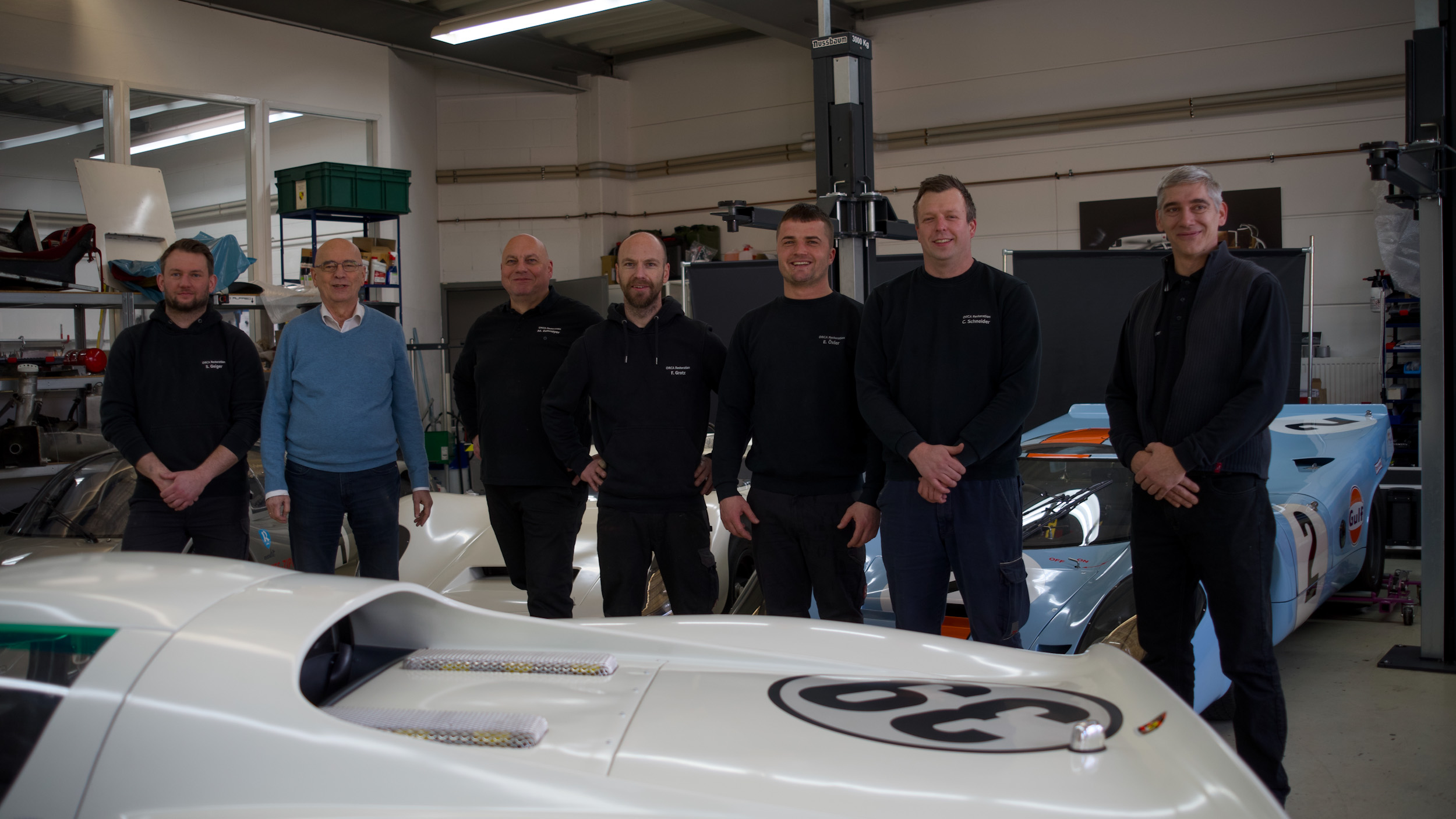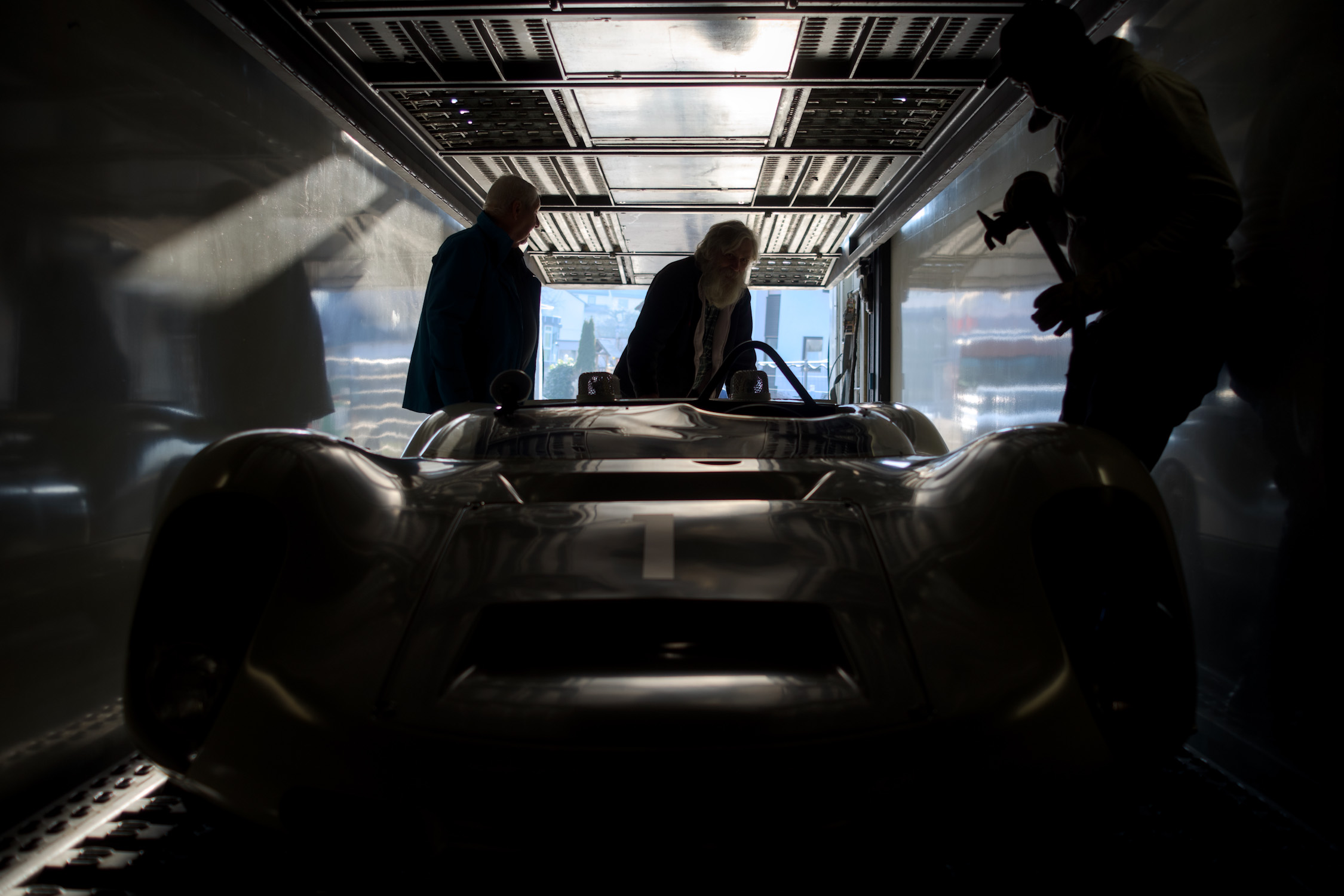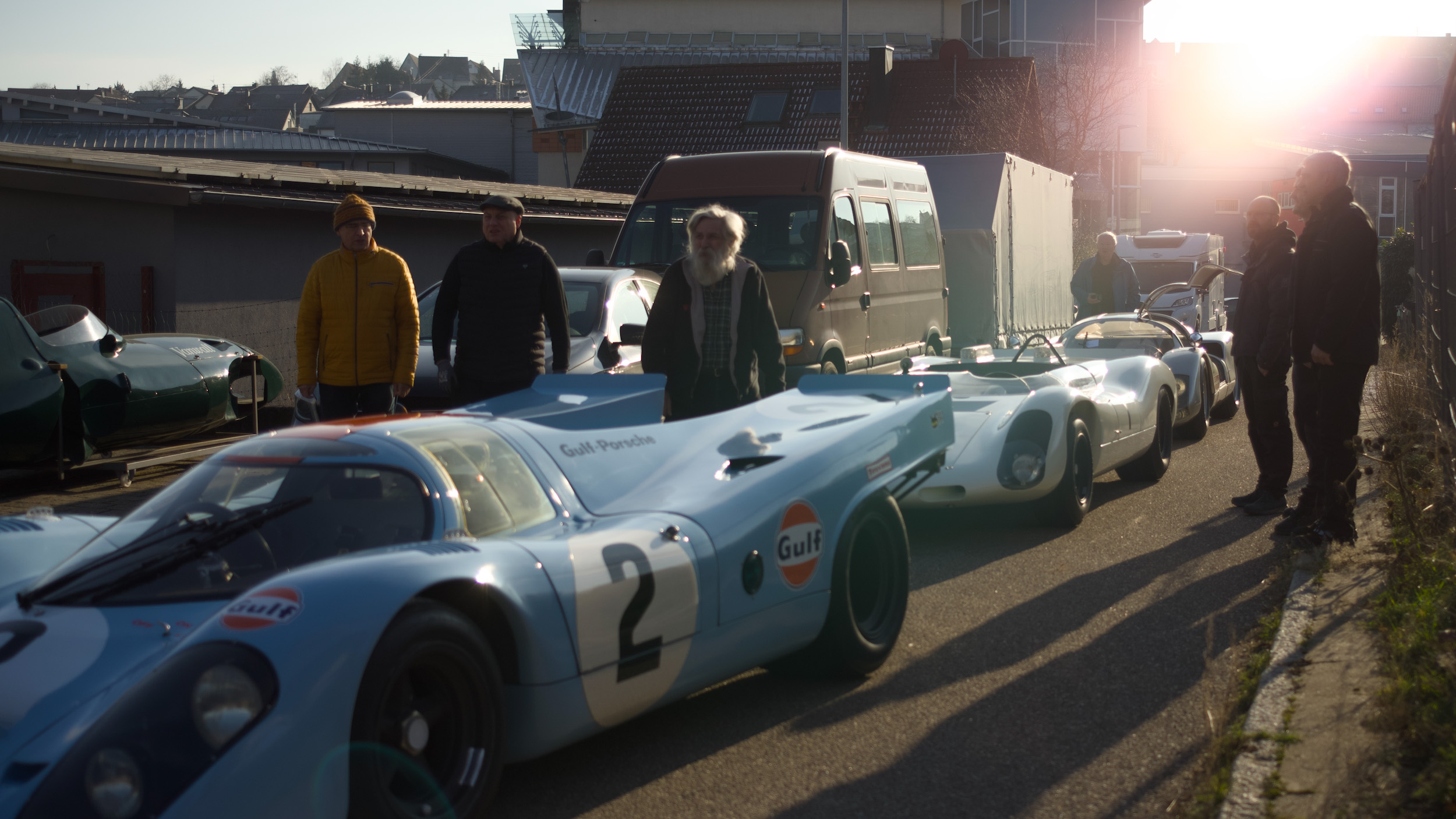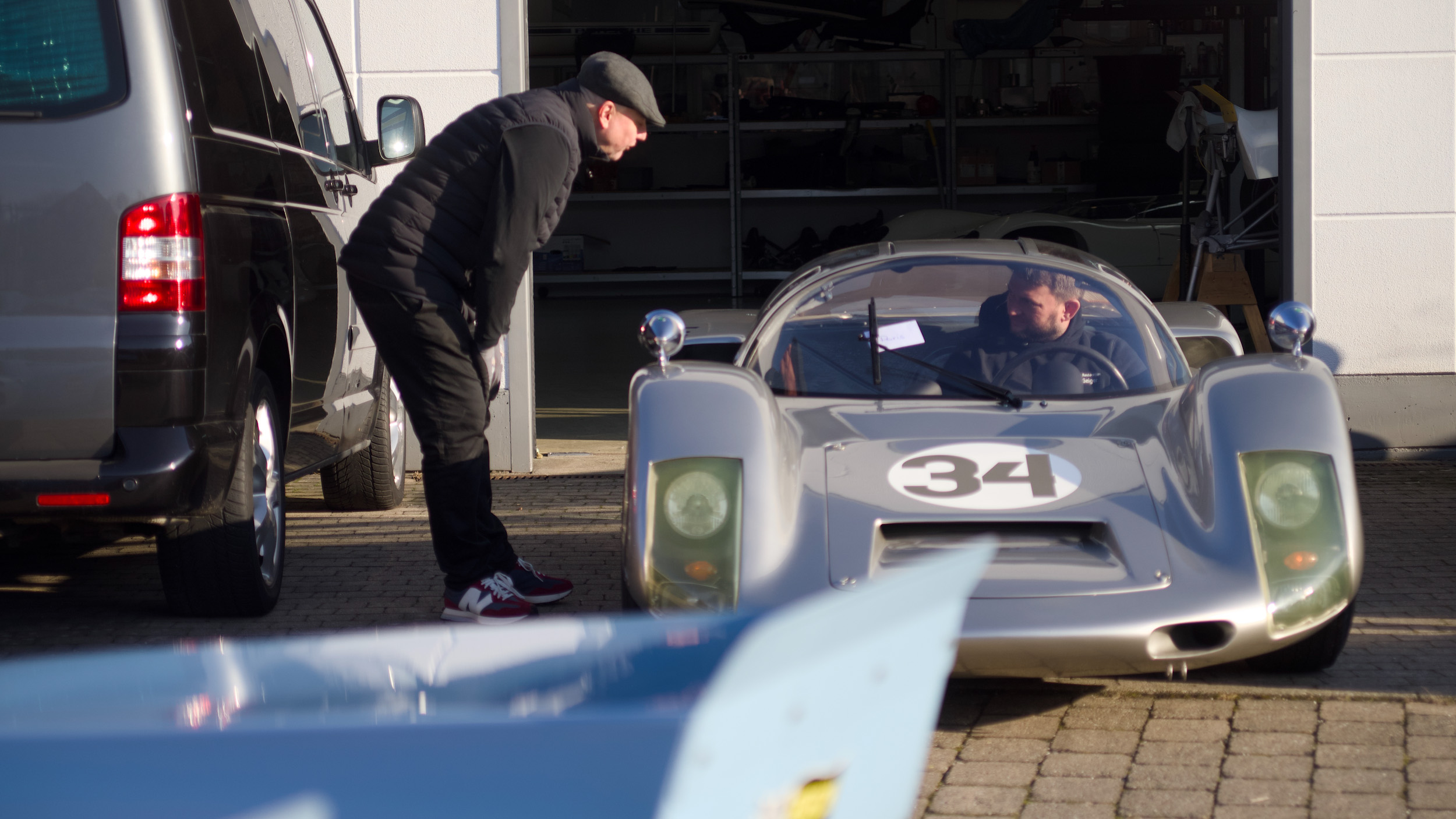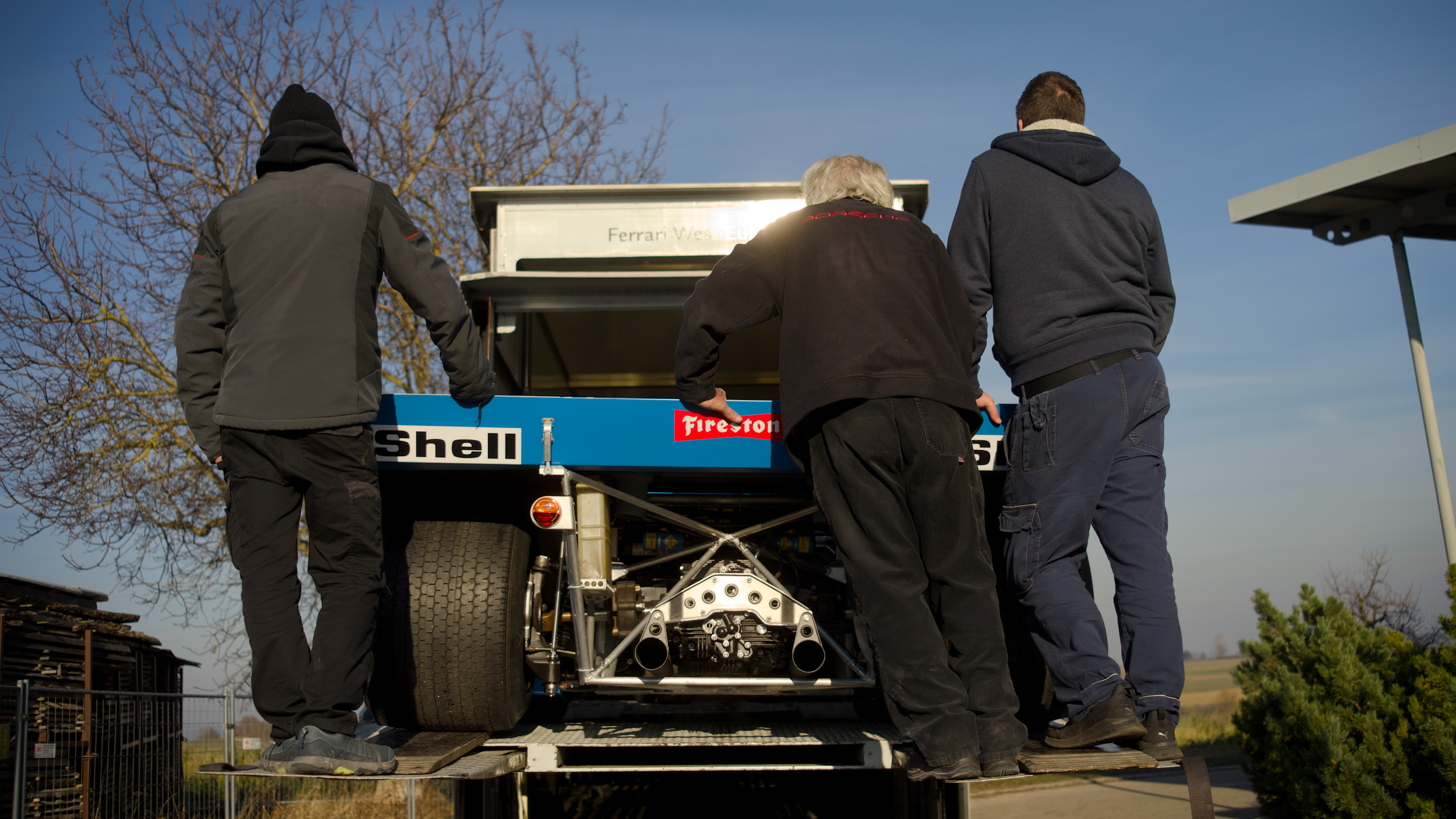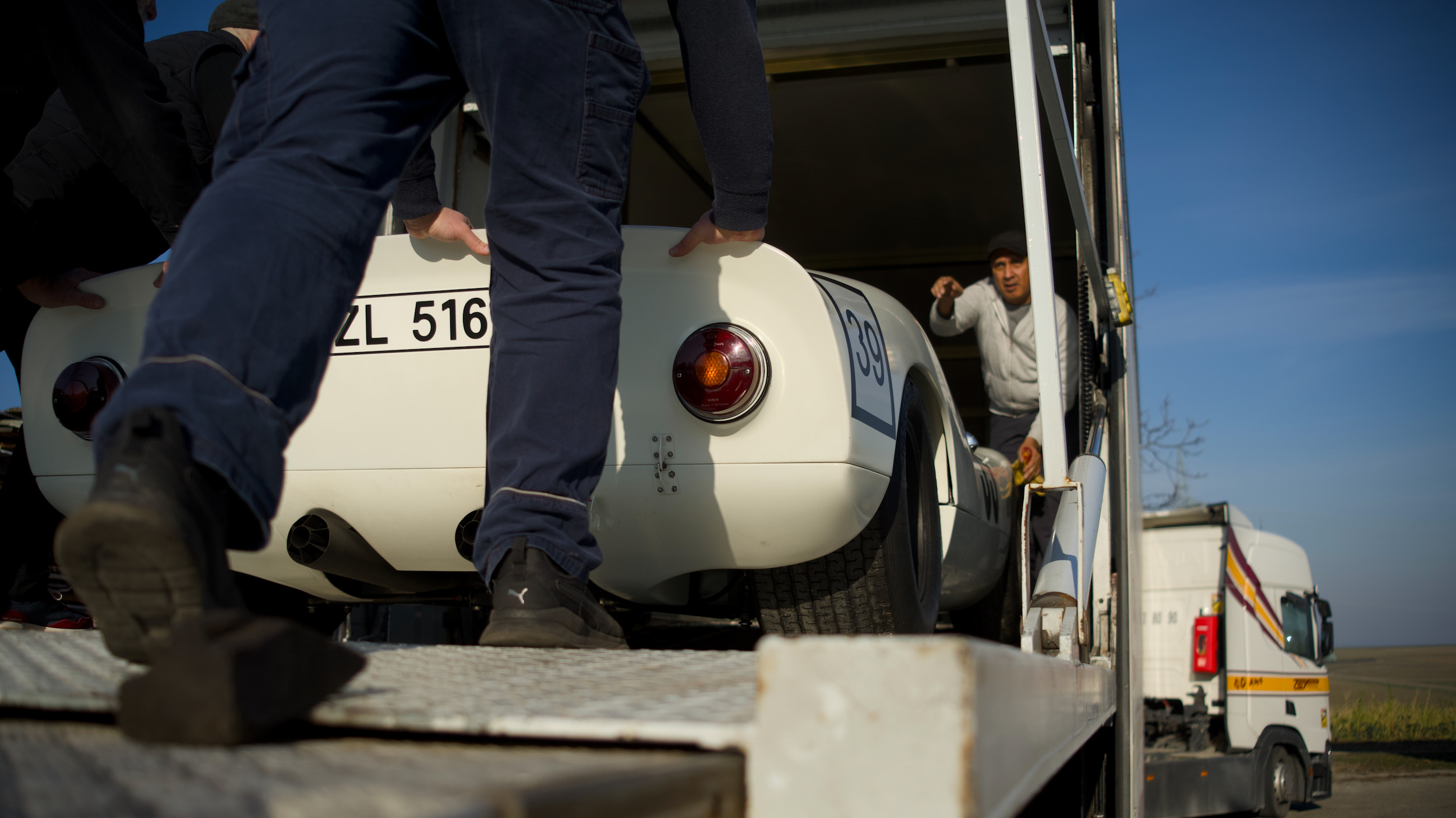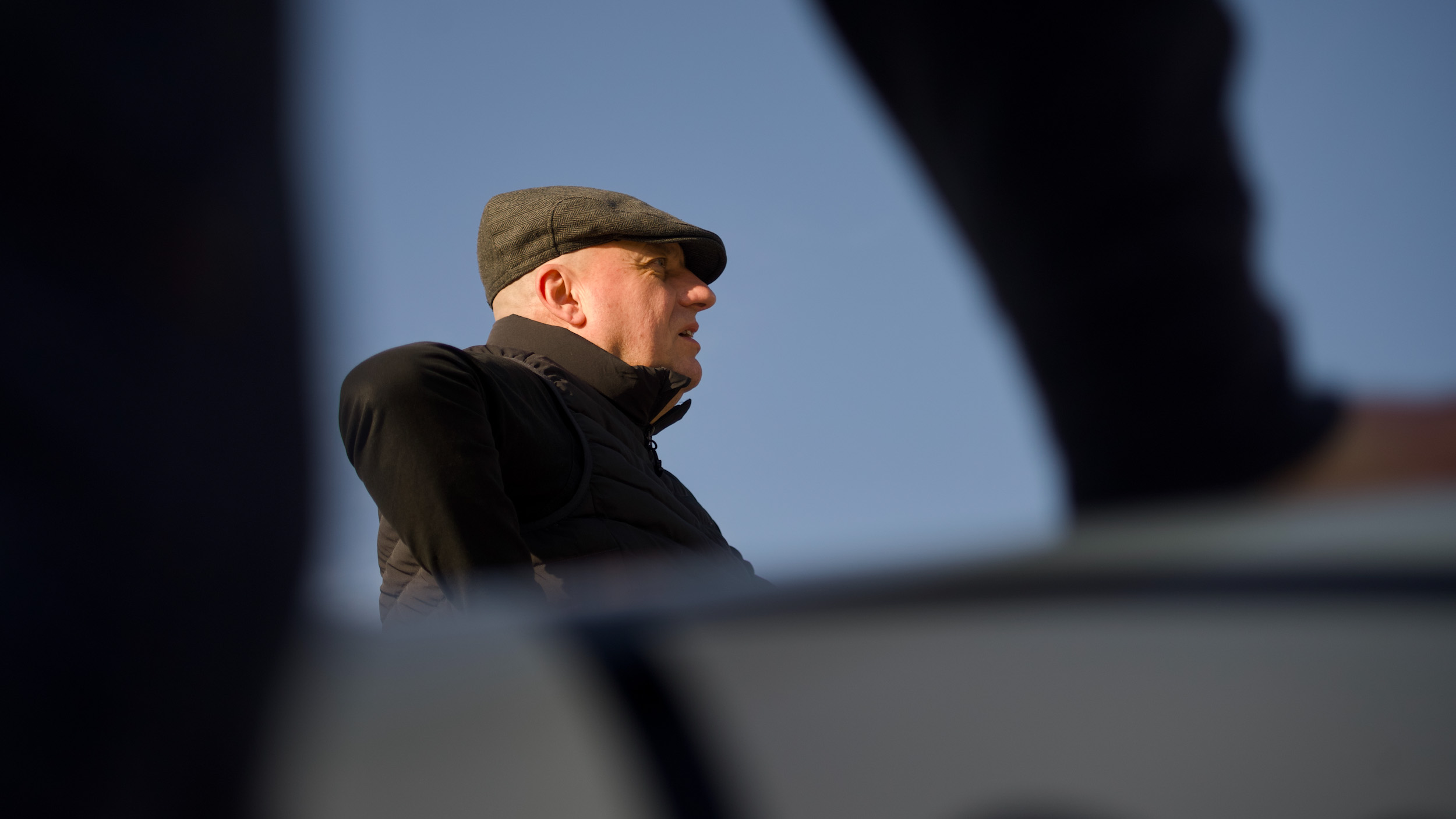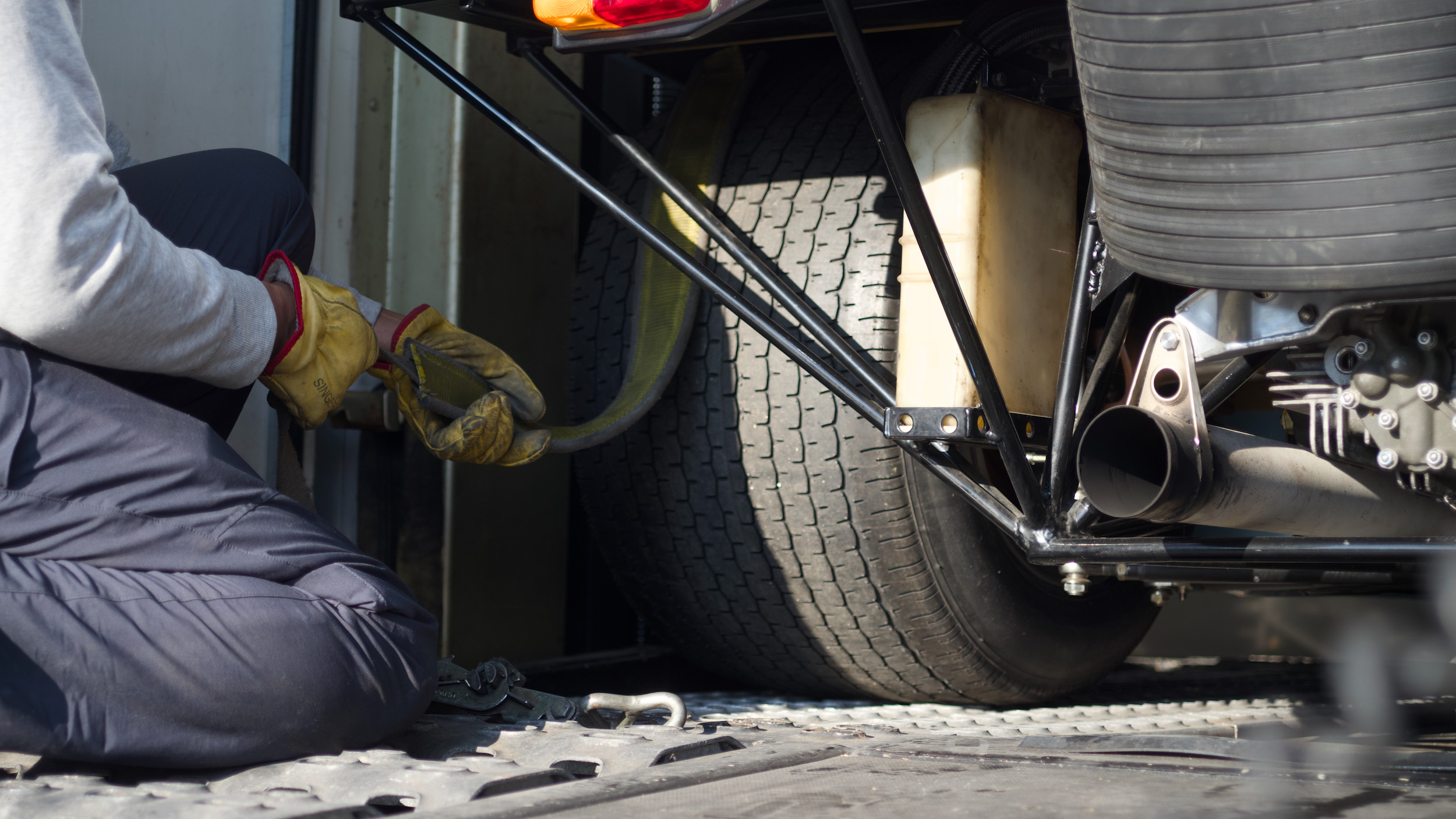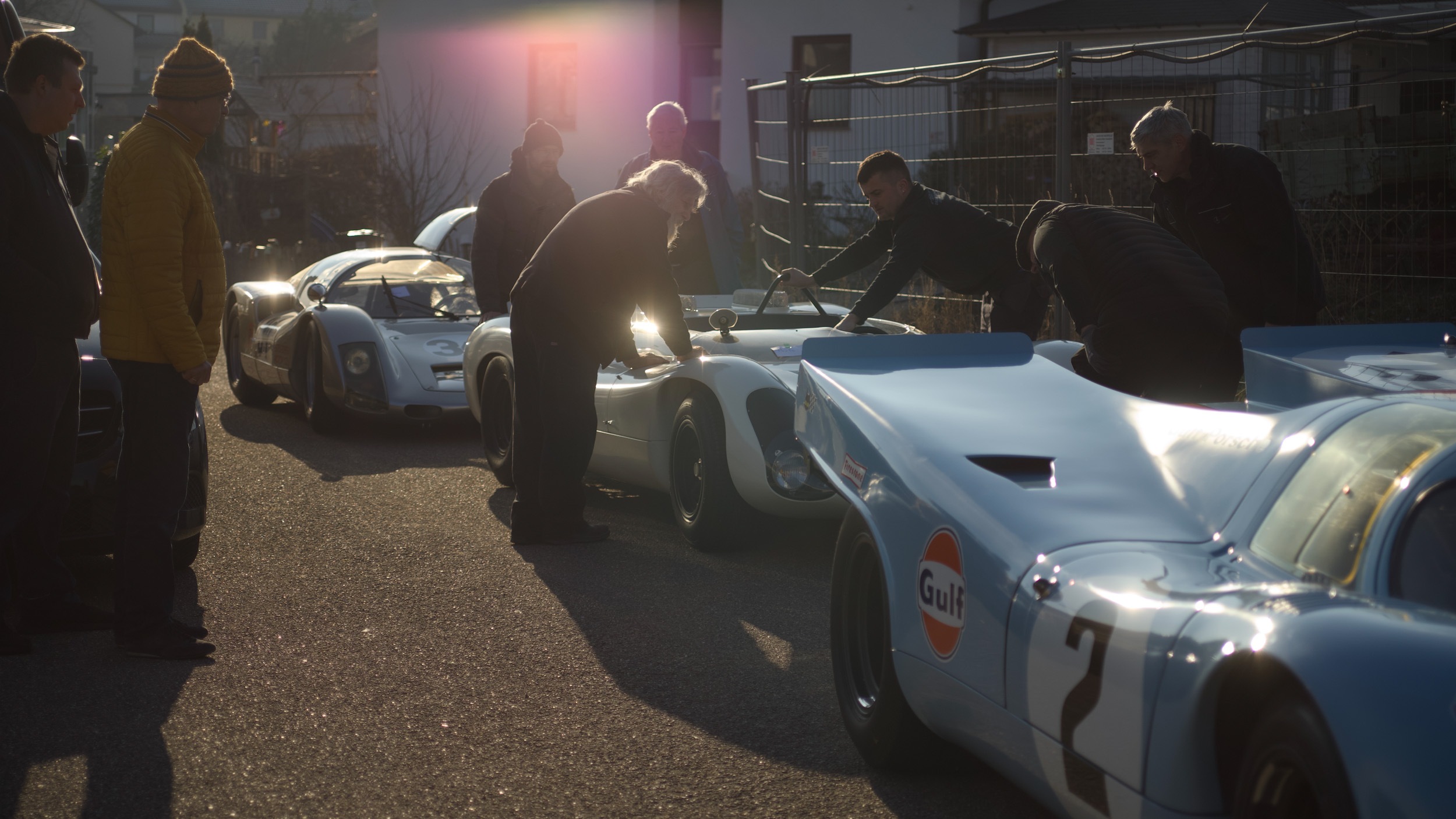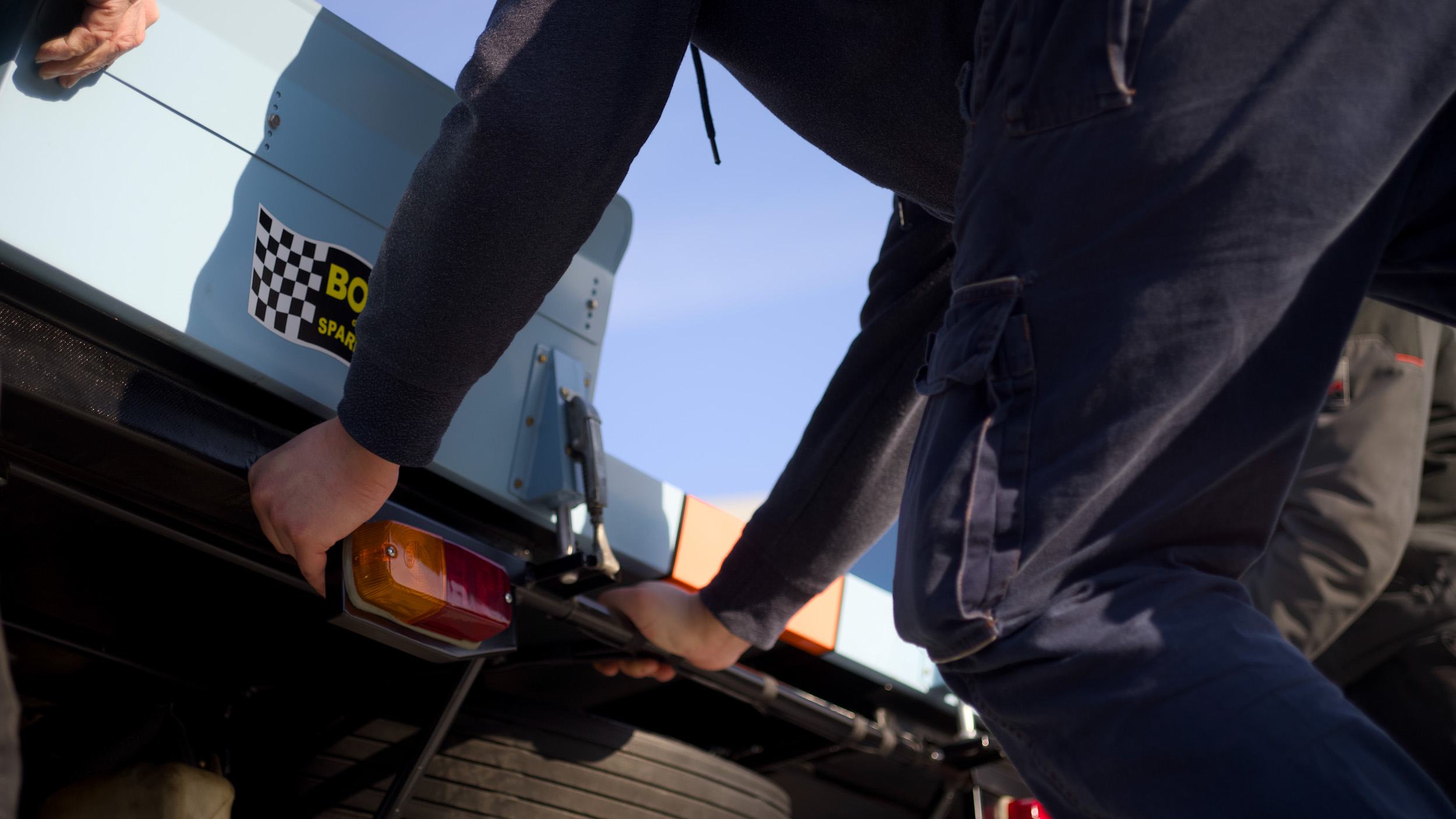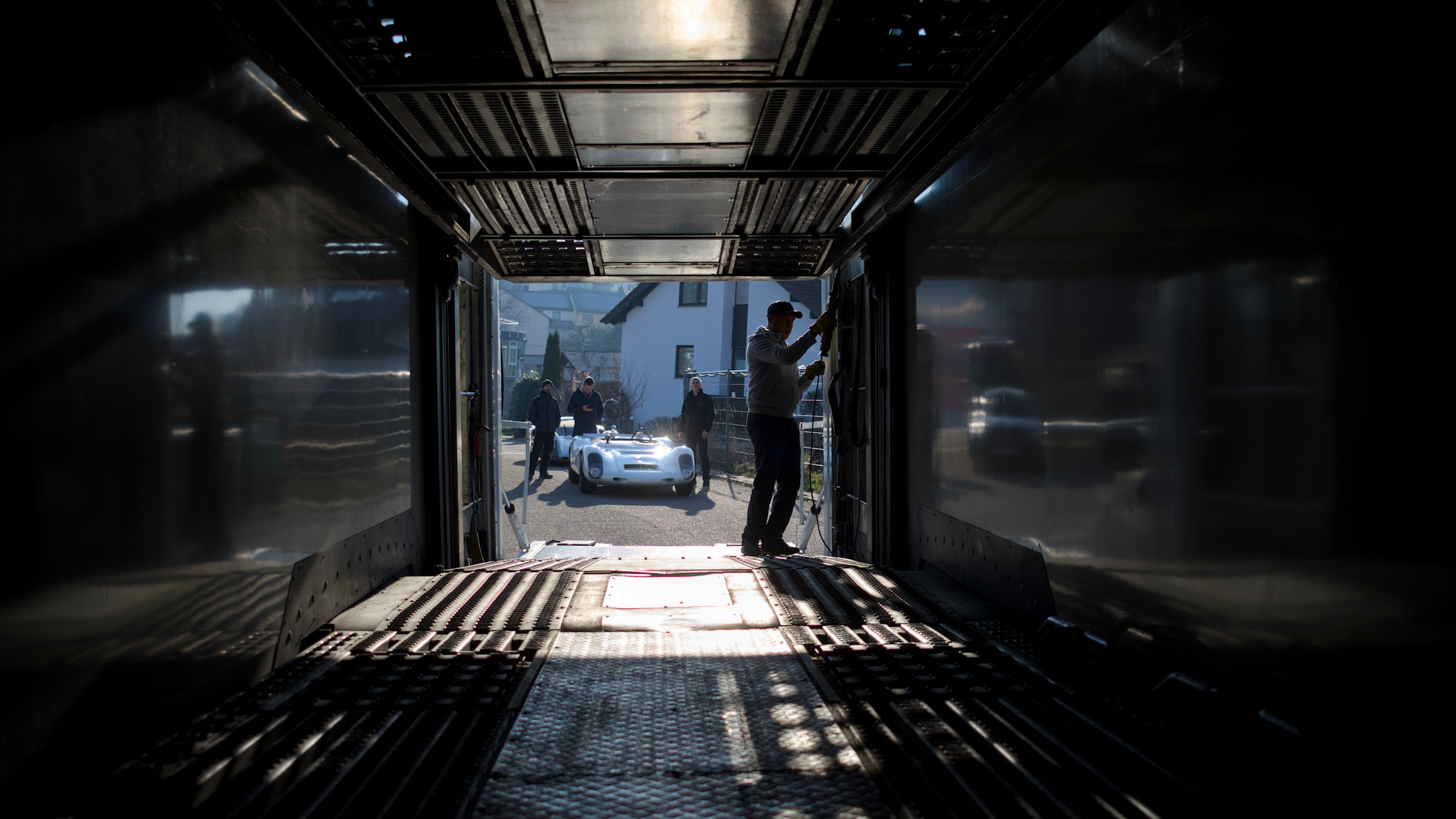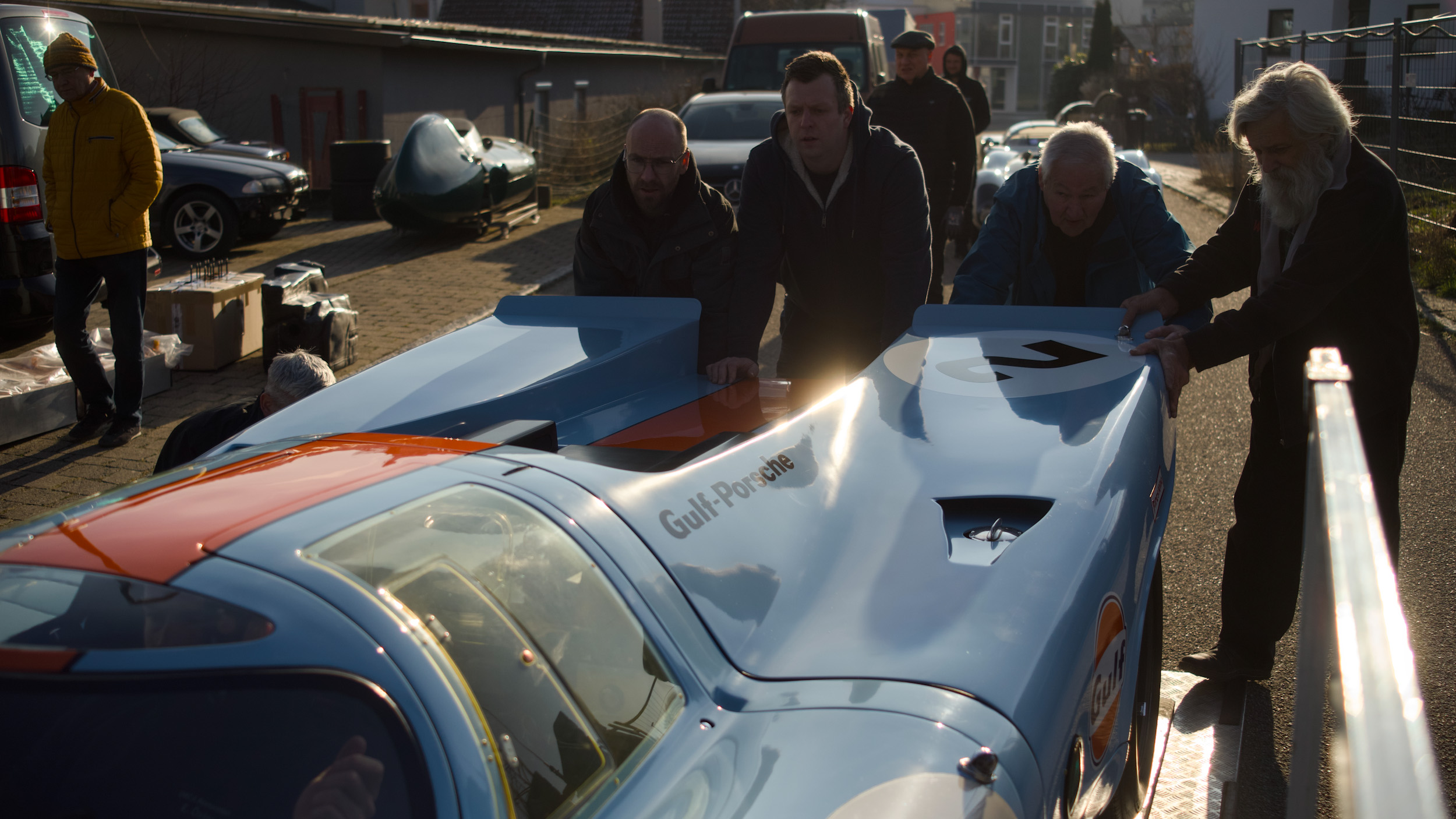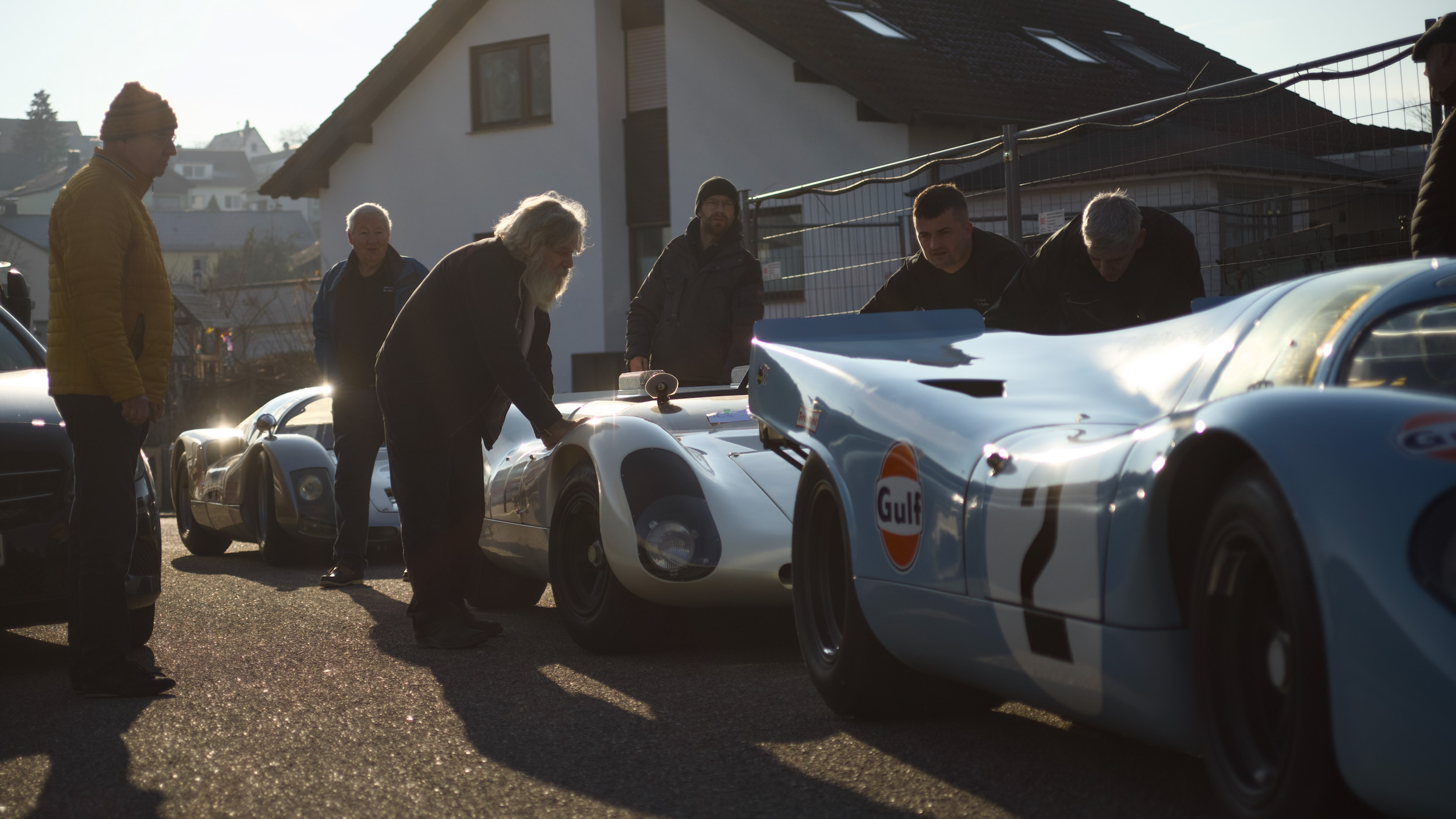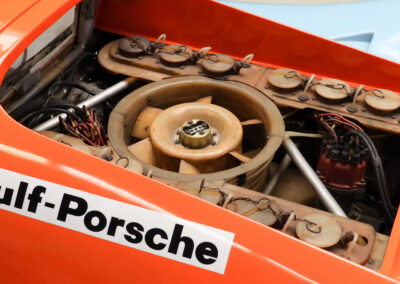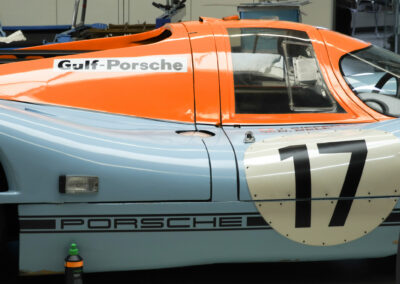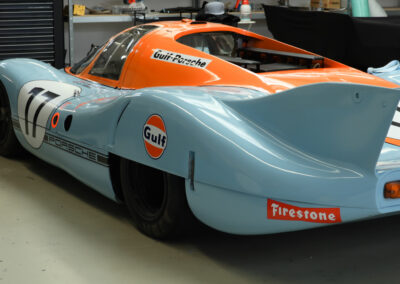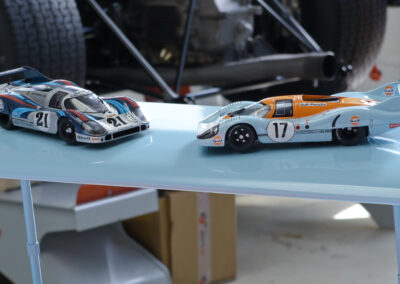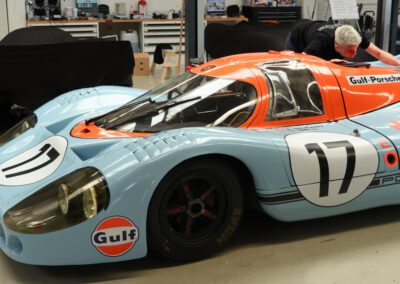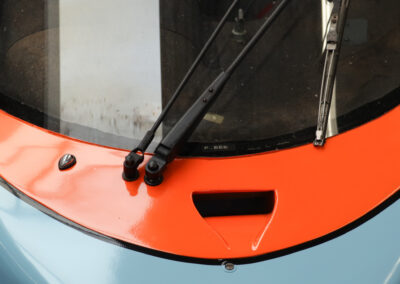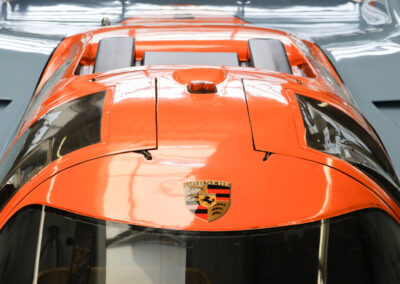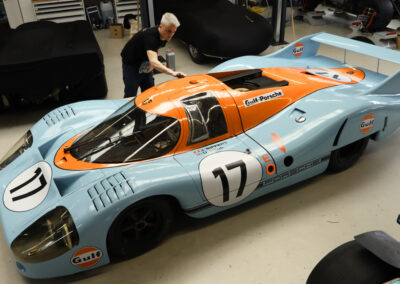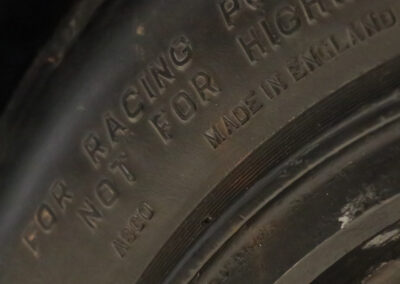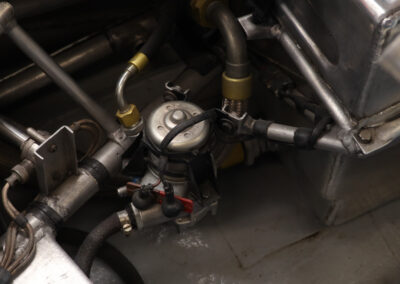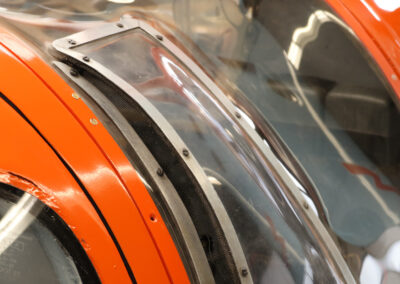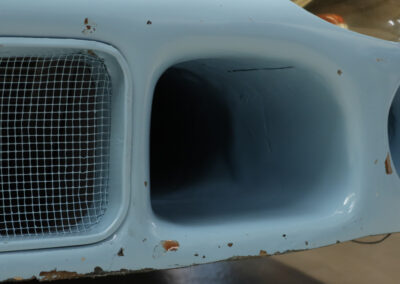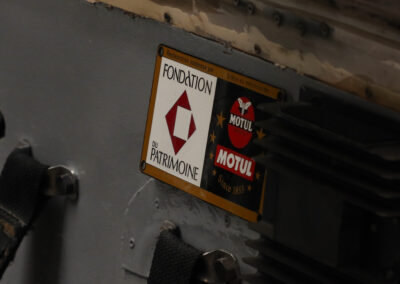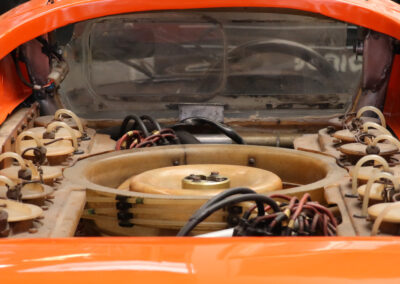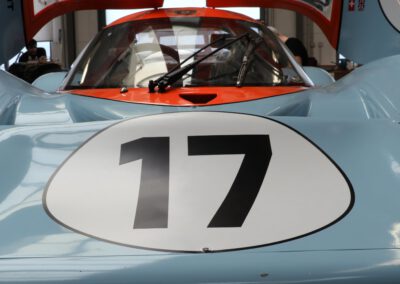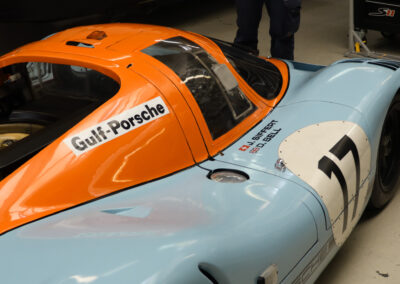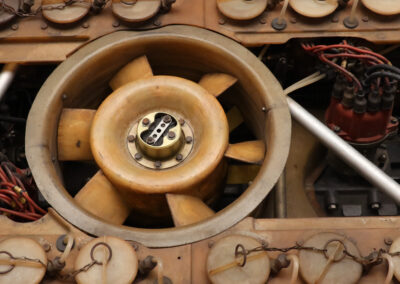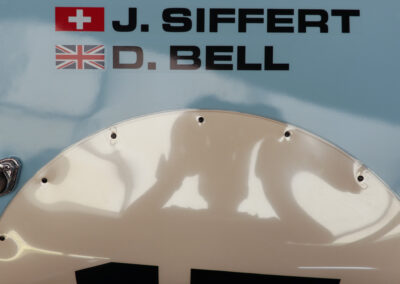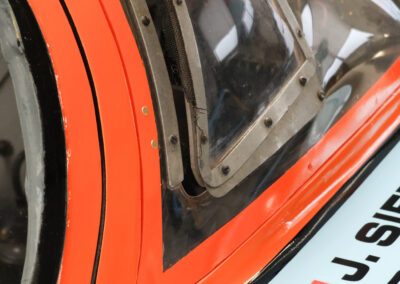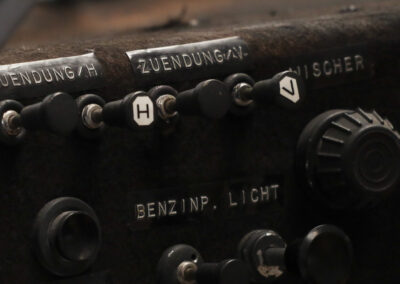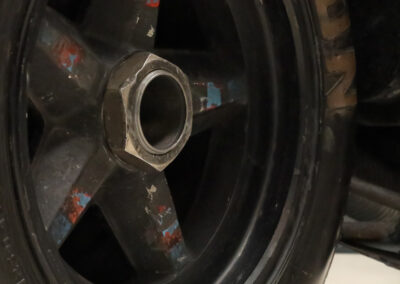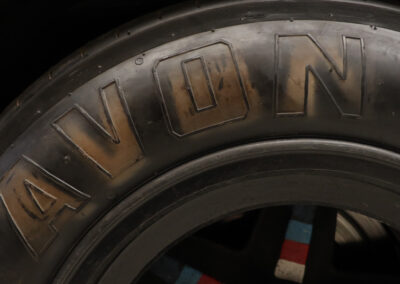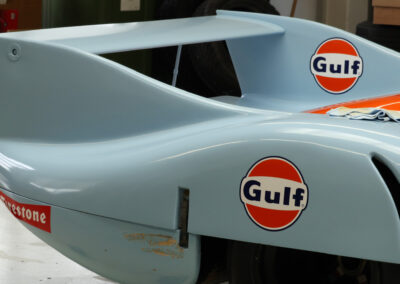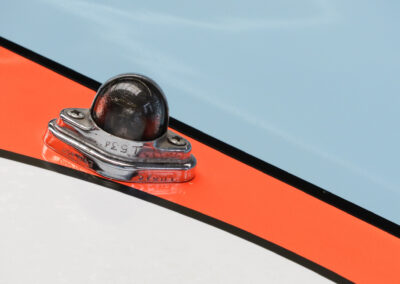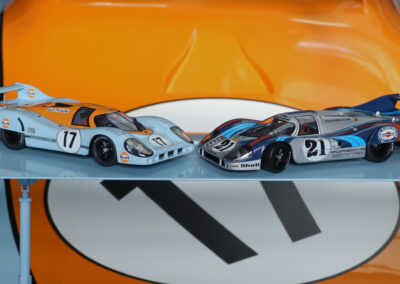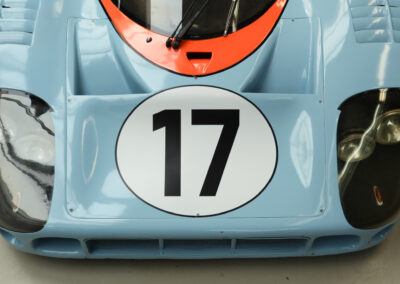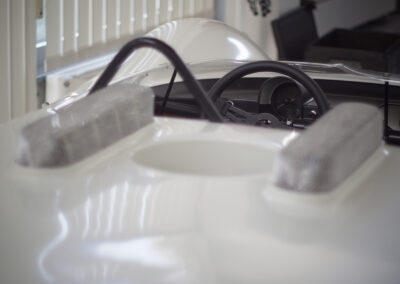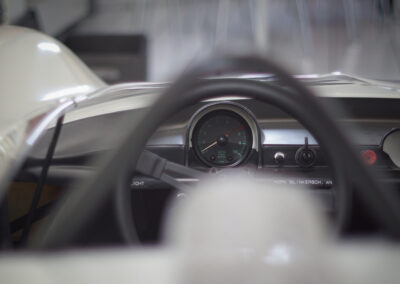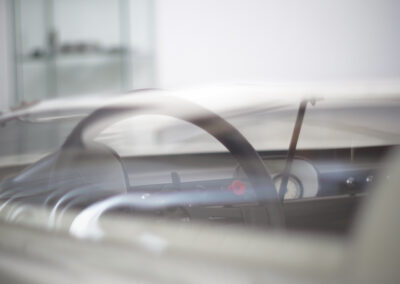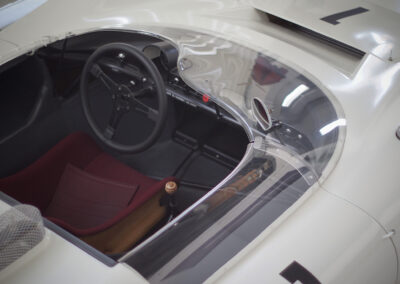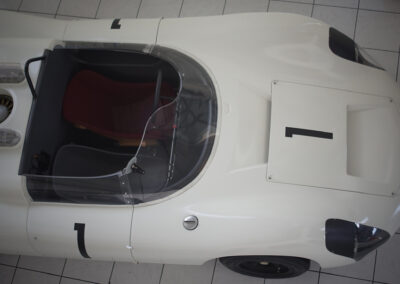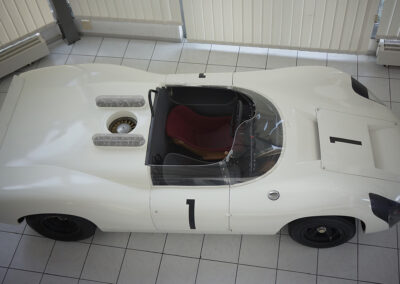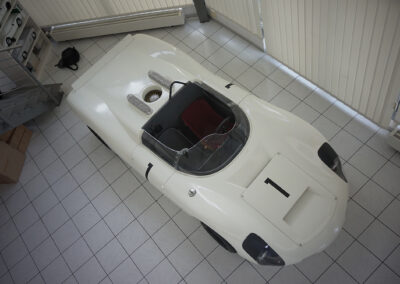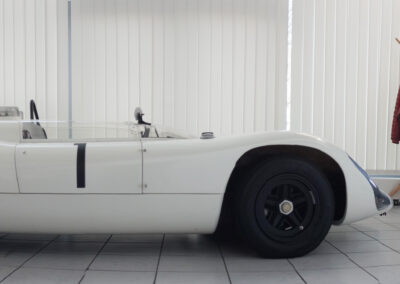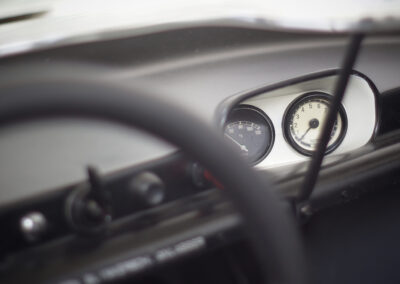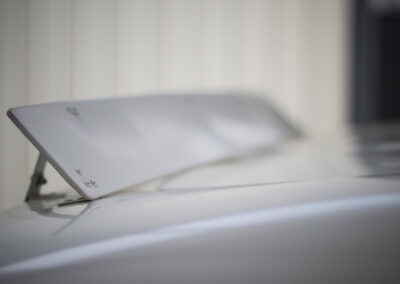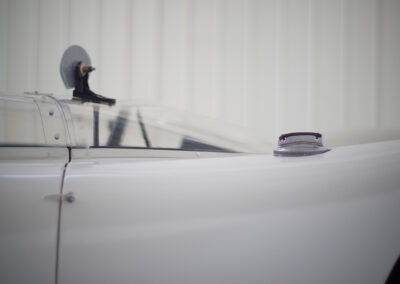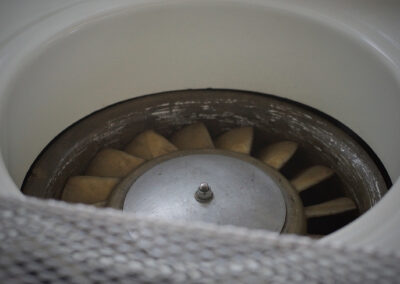PORSCHE 910 – Restored for race
Our current project is a Porsche 910, which has been undergoing a comprehensive restoration for a year. Today – on a beautiful, warm early summer morning – the vehicle’s rollout is scheduled, for which the ORCA team has reserved the Birkhau traffic training area near Kirchheim/Teck.
Alongside Alfred Kist, Emmanuel Öxler and his brother Johannes are ready to test the racing car’s handling for the first time. As soon as the 1960s thoroughbred is in motion, the throaty six-cylinder boxer engine promises a fluid and elegant driving experience. Riding as a passenger is an experience that deeply engages the senses – even on this rather narrow track, which naturally limits speed.
The first impression the Porsche 910 makes is surprising – namely, its size. Or rather, its astonishing smallness. At just 980 millimeters tall, it appears almost dainty. Yet despite its narrow fiberglass body, the car exudes an impressive presence. There’s little room inside for two adults, but our cameraman, Walter Korinek, makes himself as comfortable as possible in the narrow bucket seats, fastens his harness, and off we go.
Our encounter with the 910 is unfortunately short-lived – an approaching thunderstorm and the rapidly approaching dusk limit our time. Nevertheless, it was a fascinating experience that we won’t soon forget. What remains particularly memorable is how Emmanuel skillfully drives the small racing car through the tight, winding curves. We hope you, too, experience this same fascination when watching the film, shot from the passenger perspective.
Since the Porsche 910 was built between 1966 and 1968, we tried to capture the emotions of the 1960s when producing the film – through the layout, the music, and the editing. The goal was to bring the atmosphere of that era to life through film language. Enjoy!
Now a few more technical details:
The Porsche 910, also known as the Carrera 10, is a racing masterpiece from Porsche KG. As an evolutionary development of the legendary Porsche 906, it was used by the works team in the World Sports Car Championship and the European Hillclimb Championship between 1966 and 1968. Originally designed exclusively for use by the works team, the 910 was not a vehicle for use on public roads – unlike its predecessor, the 906.
The basis for the 910 was the proven architecture of its predecessor: the basic structure, engines and gearboxes were adopted and refined. Less than 50 units were required for homologation in motor racing, which is why only around 35 units were produced in total. The first models with a 2.0-litre six-cylinder boxer engine of type 901 were presented as early as 1966. This engine, typical for Porsche, was characterised by air cooling with an axial fan and was supplied by an injection system with a petrol-air mixture. With a compression ratio of 10.3:1, it achieved a maximum output of 162 kW (220 hp) at 8,000 revolutions per minute.
Power was transmitted to the rear axle via a fully synchronised five-speed manual gearbox of type 906, which was based on the standard gearbox of the Porsche 911. The drive system was supplemented by a limited-slip differential to ensure traction at the highest level – a testament to the technical sophistication of this racing car.
Sie können alle Filme mit Untertiteln in der Sprache Ihrer Wahl abspielen. Bitte das Icon „“Untertitel“ anklicken und ggf. im Symbol „Einstellungen“ die gewünschte Sprache wählen.
You can play all films with subtitles in the language of your choice. Please click the „Subtitles“ icon and, if necessary, select the desired language in the „Settings“ icon.
Vous pouvez visionner tous les films avec des sous-titres dans la langue de votre choix. Veuillez cliquer sur l’icône « »Sous-titres« » et, le cas échéant, sélectionner la langue souhaitée dans l’icône « Paramètres ».
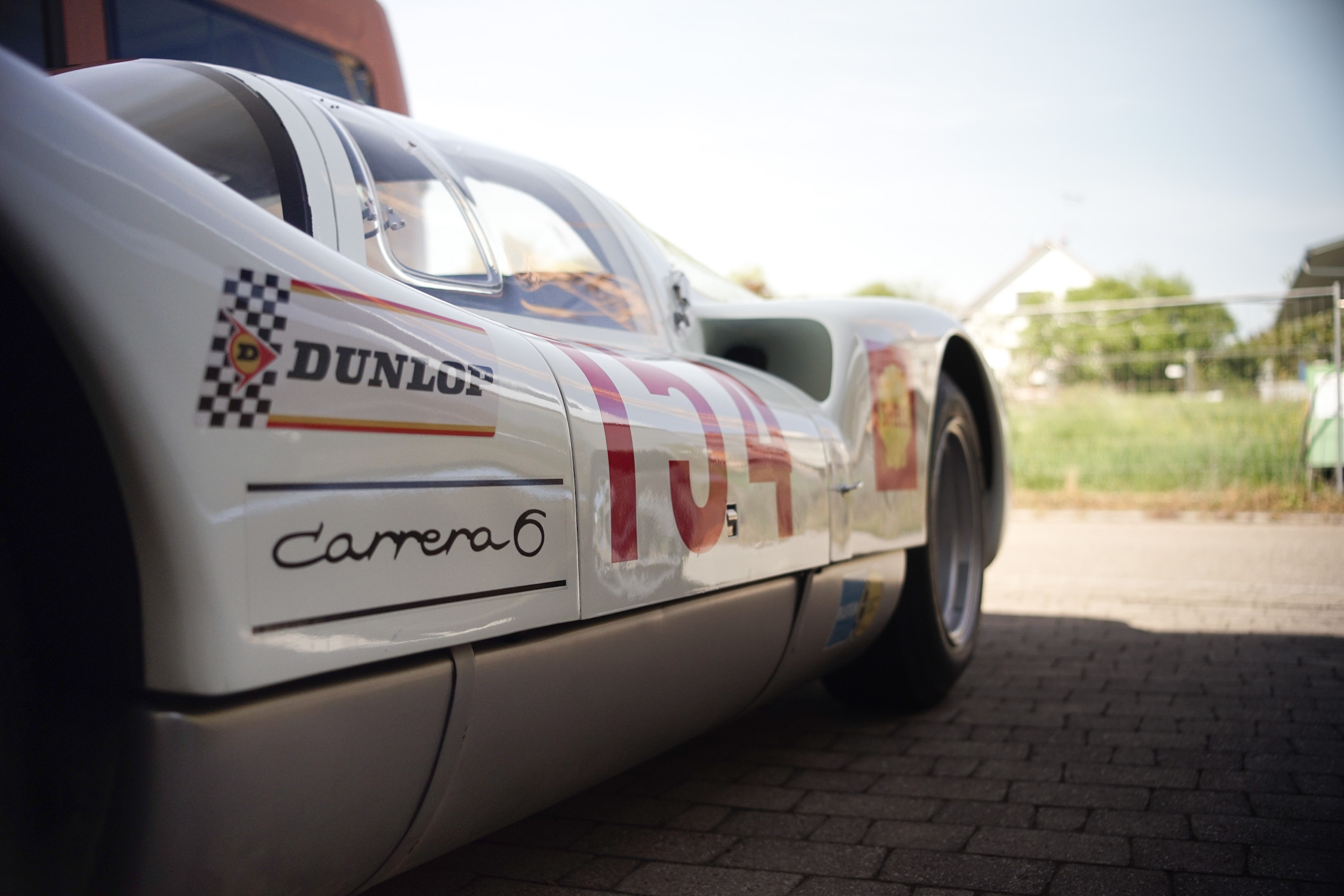
Porsche 906 - Carrera 6
The 906 marked the start of a new era for Porsche – the era of pure racing cars in lightweight construction began. In 1966, at the instigation of Ferdinand Piëch, the Carrera 6 – the official sales designation – was launched with a newly developed tubular frame as a racing car with homologation for the sports car class of the World Sports Car Championship. In addition, the Porsche Carrera 6 also had a licence for public road traffic. According to the FIA regulations, at least 50 vehicles of this type had to be produced and sold. 67 examples were produced and sold mainly to private customers. At the time, the car cost DM 45,000 ex works.
The Porsche 906 with chassis no. 126 was sold in 1966 as a customer vehicle to the Swiss car collector and racing driver Dr Hans Kühnis, who raced it very successfully as a private driver for decades. The car made its debut at the 1966 Targa Florio, where a total of 10 Porsche 906s competed, including four works cars. And Porsche was indeed the overall winner, with Hans Kühnis finishing in 15th place. In 2004, the doctor and racing driver Dr Armin Zumtobel bought the vehicle, which he drove in numerous races until 2020, including the Le Mans Classics under the name ‘Team Tintin’, the Festival of Speed in Goodwood, Monza and numerous hill climbs. He even achieved 1st place in the Arosa ClassicCars 2013.
Austrian racing driver Rudi Lins recounts some of his experiences with this vehicle. When he won the European Hillclimb Championship for sports cars in a Porsche 906 Carrera 6 in 1967, he had long been a Porsche works driver.
After more than five decades of service on the world’s racetracks, the car was involved in an accident on the Salzburgring. The car was badly damaged, but the driver, Dr Armin Zumtobel, was able to get out almost unharmed. In 2022, the new owner decided that the 906/126 should be given a complete restoration by Alfred Kist and his team at Orca Restorations in Eberdingen-Nussdorf. The aim was to restore the car to its original condition at the time of delivery.
The film depicts episodes from this car’s life. Basic information about this special vehicle is followed by some scenes from races and then impressions from the restoration process led by Alfred Kist, in which the vehicle is rebuilt and ready to drive again at the end. The film depicts this period from July 2020 to May 2023, but it is also about the expertise and passion of the people involved and all of this is linked by the Carrera 6, making this film about the Porsche 906 with chassis number 126 an experience for every lover of the racing car scene.
.
In 2004, the doctor and racing driver Dr Armin Zumtobel bought this Carrera 6 and competed in numerous races with it until 2020. After more than five decades of service on the world’s racetracks, the car was involved in an accident on the Salzburgring on 10 July 2020. The car was badly damaged, but the driver Dr Armin Zumtobel was able to get out almost unharmed. Alfred Kist and Emmanuel Öxler show here how the crash happened and why the driver was unharmed.

Porsche 550 Spyder Protoype
In summer 2019, Alfred Kist received a call from the new owner of a Porsche 550 Spyder prototype with chassis number 12 from 1954. The owner wanted the vehicle, which still had the original paintwork from that year’s Carrera Panamericana, to be repainted back to the original livery it originally had at the start in Le Mans. The original nitro paintwork was to be restored. After consultation with the owner, the car was repainted in silver with the starting number 39 and turquoise blue colour markings on the rear side edges.
Although the restoration order for the Porsche 550 Spyder was officially completed, it turned out during the starting tests that the vehicle was not technically in order. When examining the electrics, the team discovered a short circuit, which was quickly rectified, but meant that many components such as the master brake cylinder, all wheel brake cylinders and the petrol pump had to be removed and checked.
The search for the start number lighting at the rear of the Porsche 550 Spyder proved to be extremely difficult, comparable to looking for a needle in a haystack, as Alfred Kist describes it. This special lighting was an important detail that had been lost in the course of the vehicle’s history. After a long search, the team finally found the missing component and was able to restore the vehicle to exactly the same condition as it was at Le Mans in 1954. A similar problem occurred with the rear lights: The existing lamp holder did not correspond to the original and allowed light to shine through the reflector. As the original component was no longer available, the team decided to create a new design using a CAD scanner and 3D printer. They cast the parts to reproduce the rear light.
In summer 2020, after almost a year of restoration, the Porsche 550 Spyder prototype was launched and ran flawlessly. The vehicle was then extensively tested. After correcting the ignition timing, the veteran reached its full power. The final step was to put it to the test on the road.
Finally, the restored vehicle was returned to its owner, who made it available to the Le Mans Museum as an exhibit. The car thus returned to the site of its first triumph. Since then, the Porsche 550 Spyder has been a major attraction at the museum.
.
Reading tip
Issue 63/March 2023 of Octane – the German edition of the international magazine – featured a detailed article about this very special car and its restoration.
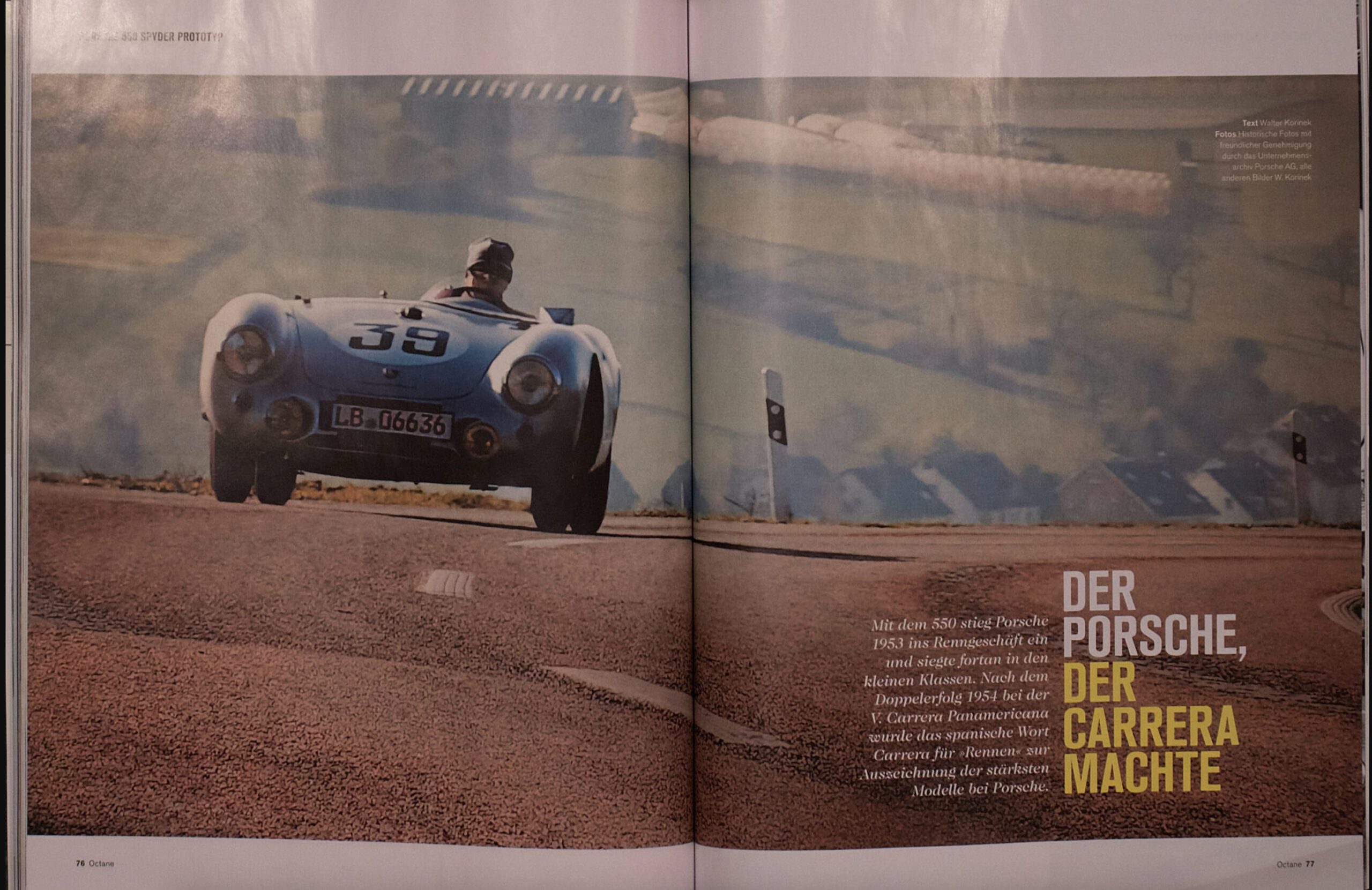
(Filme von Walter Korinek)
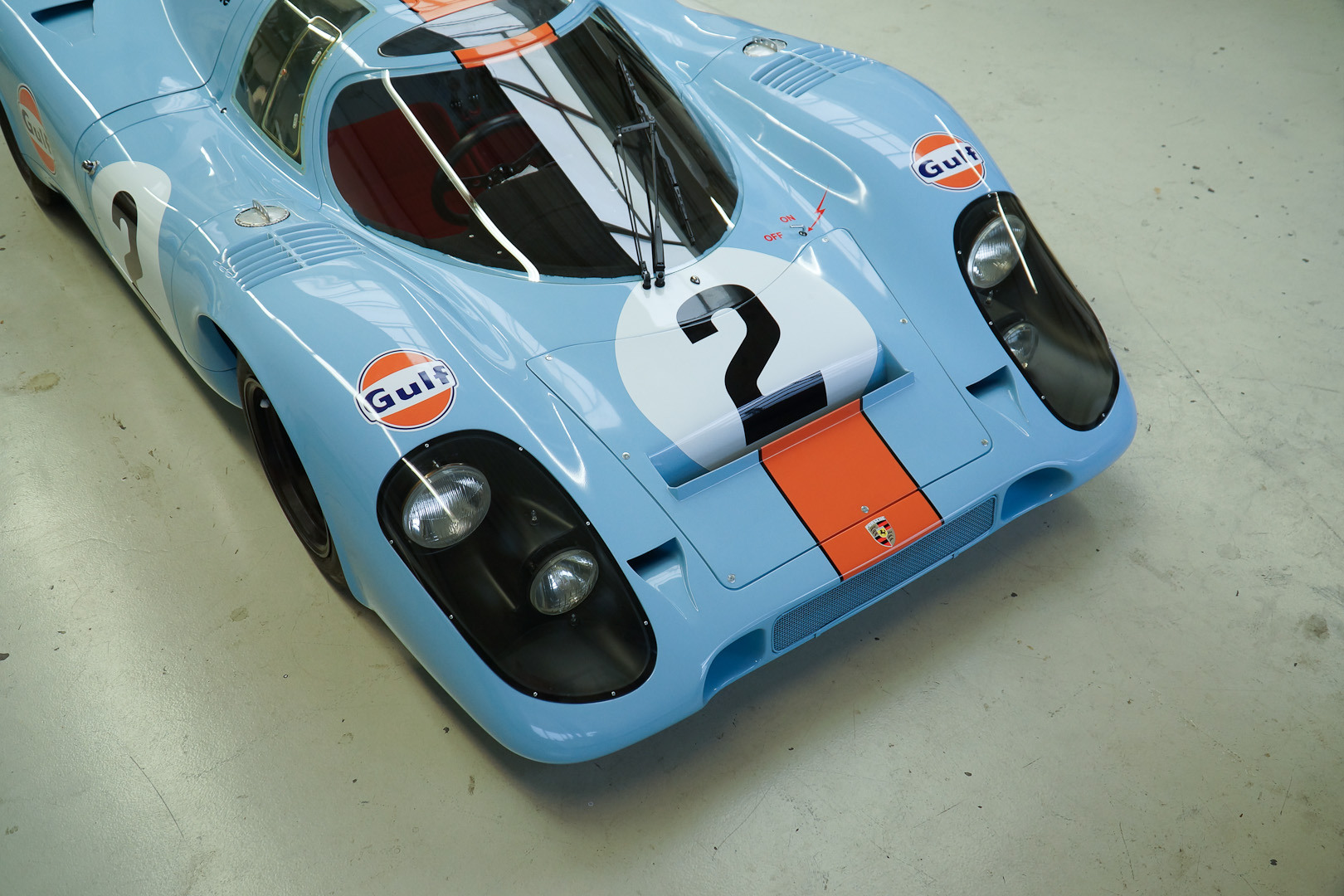
Porsche 917-15
The film ‘Milestones of a restoration’ describes the restoration of a classic car from automotive racing history at ORCA RESTORATION. The vehicle – a Porsche 917 – is a racing car built by the German car manufacturer Porsche in 1970. At the Daytona 24-hour race that year, Porsche won the overall victory with this car, driven by Pedro Rodriguez and Leo Kinnunen. Outside of the racing scene, the car with the Gulf colours became a legend thanks to the 1971 film classic ‘Le Mans’ with Steve McQueen.
After almost 50 years with various collectors and various conversions, the Porsche 917 with chassis no. 15 came to ORCA RESTORATION in Nussdorf in 2020 to be restored to its original condition from 1970. The work on this vehicle took over three years until it was returned to its owner in January 2024 in race-ready condition, just as it had left the Porsche racing department in Zuffenhausen in 1970.
.
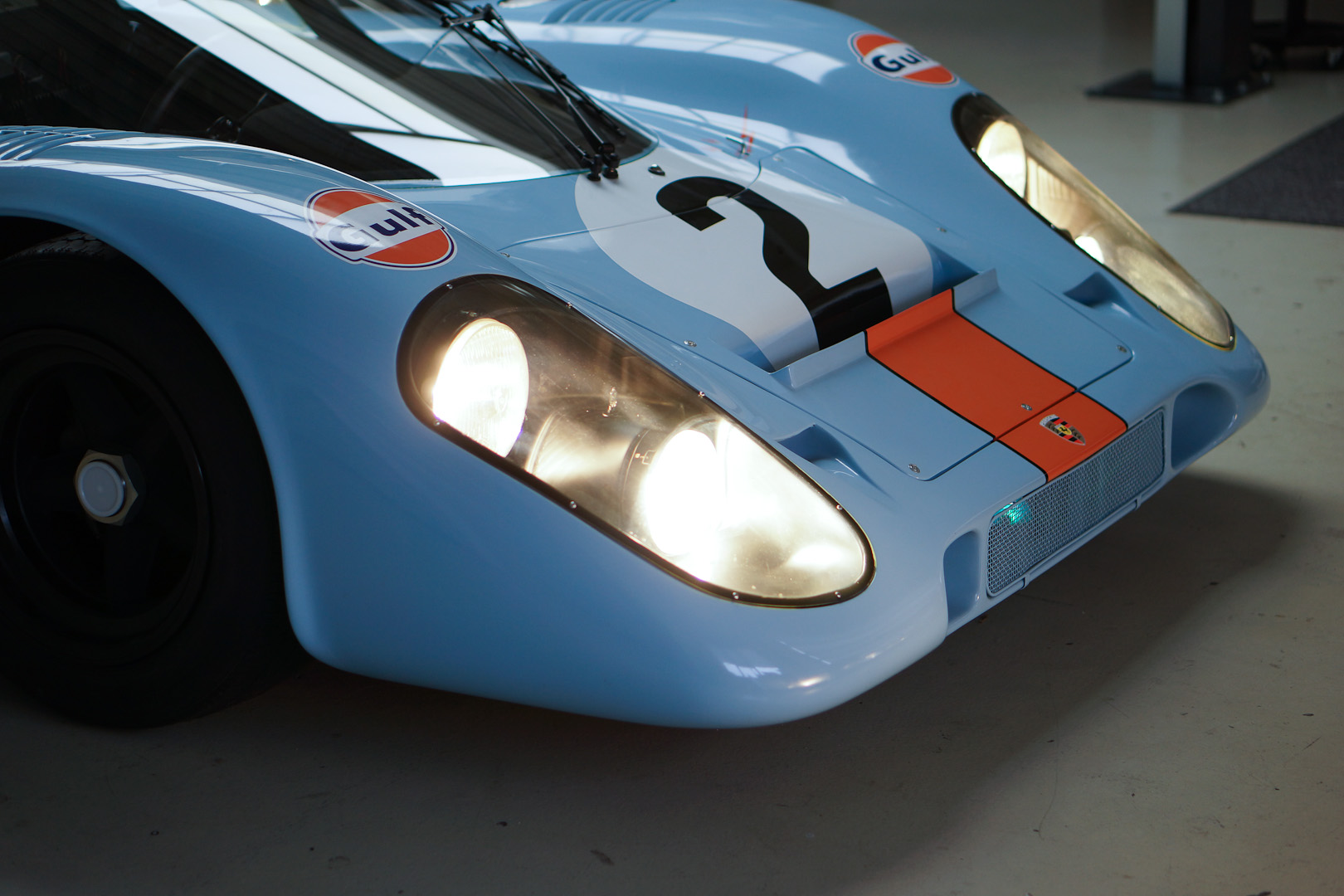
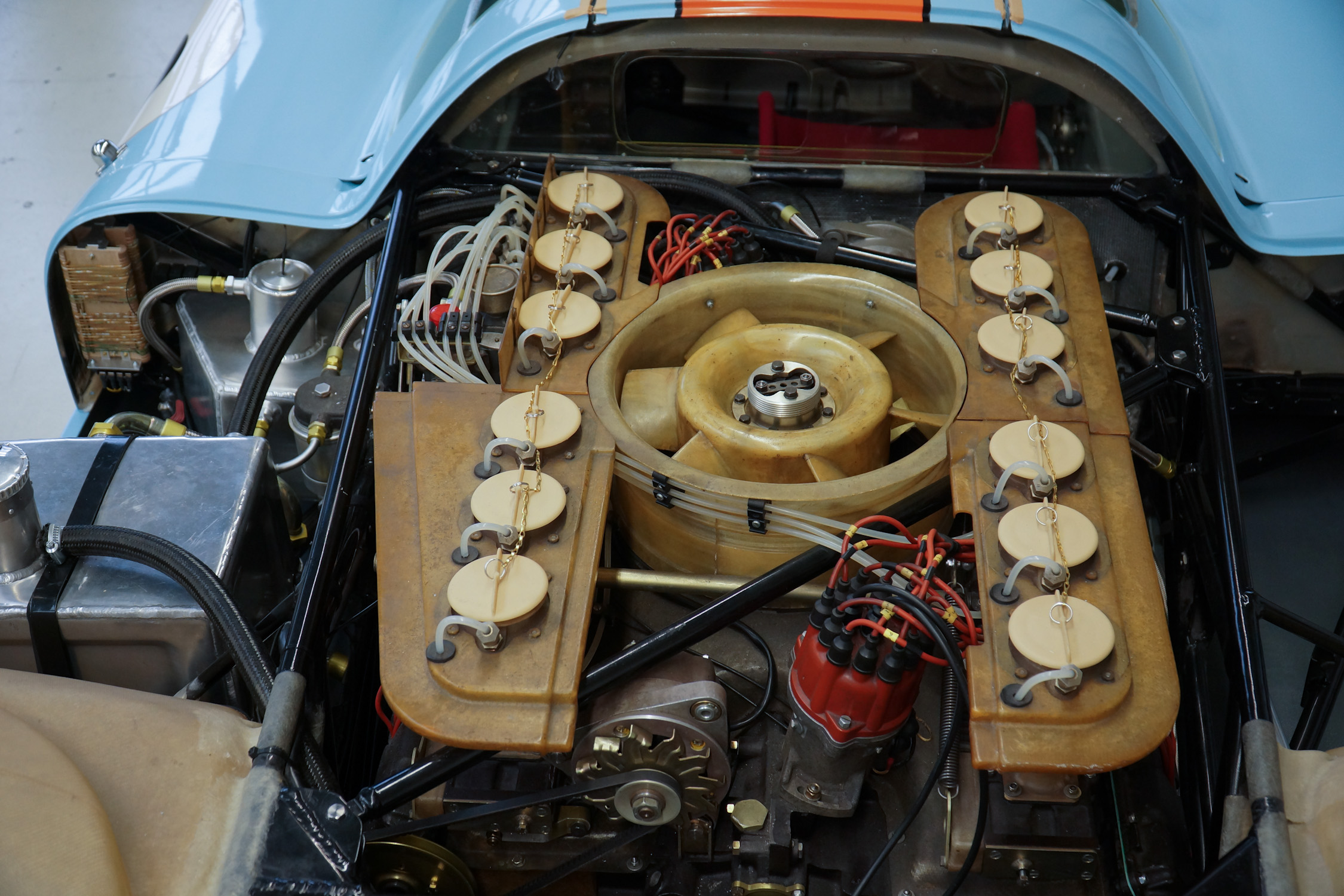
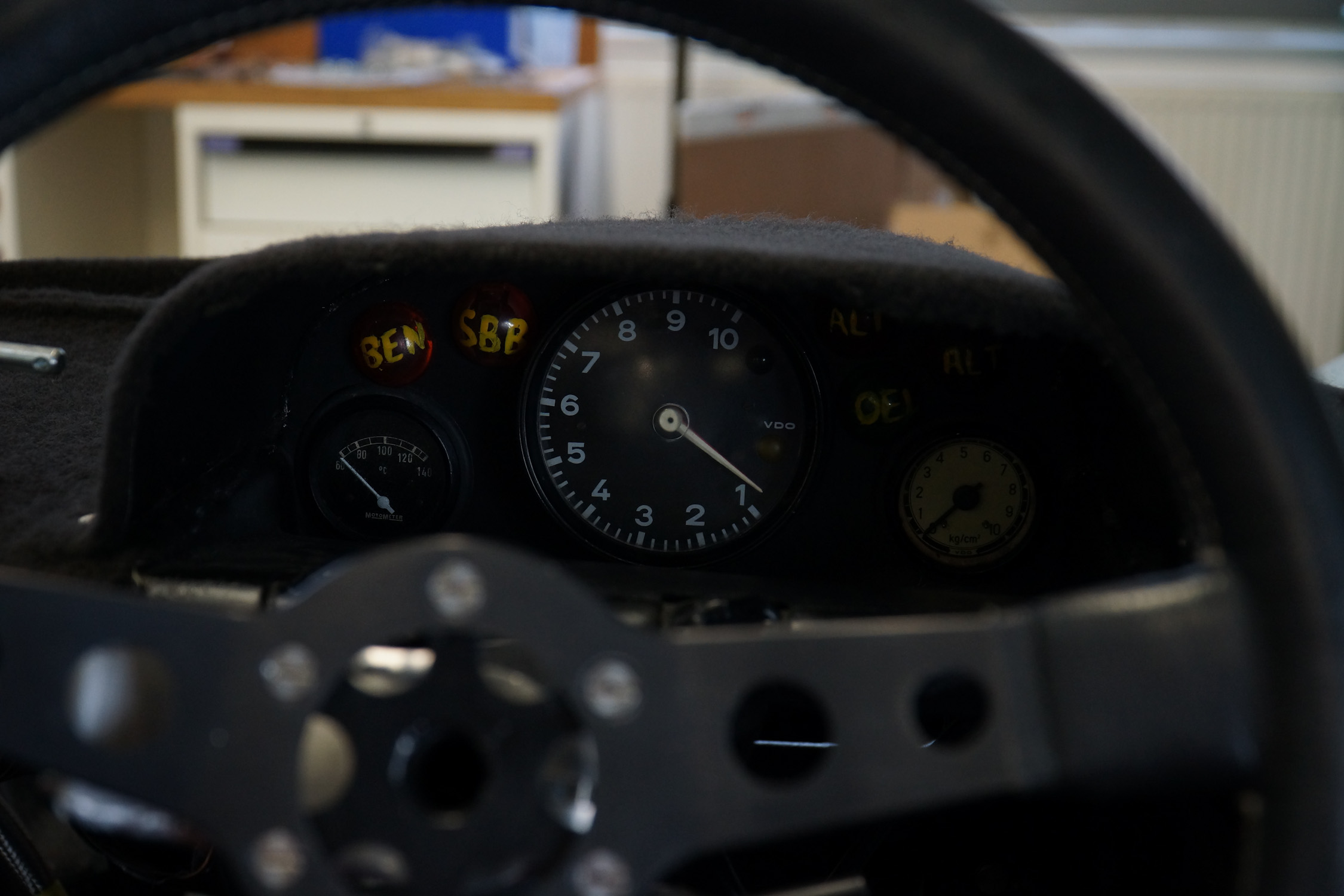

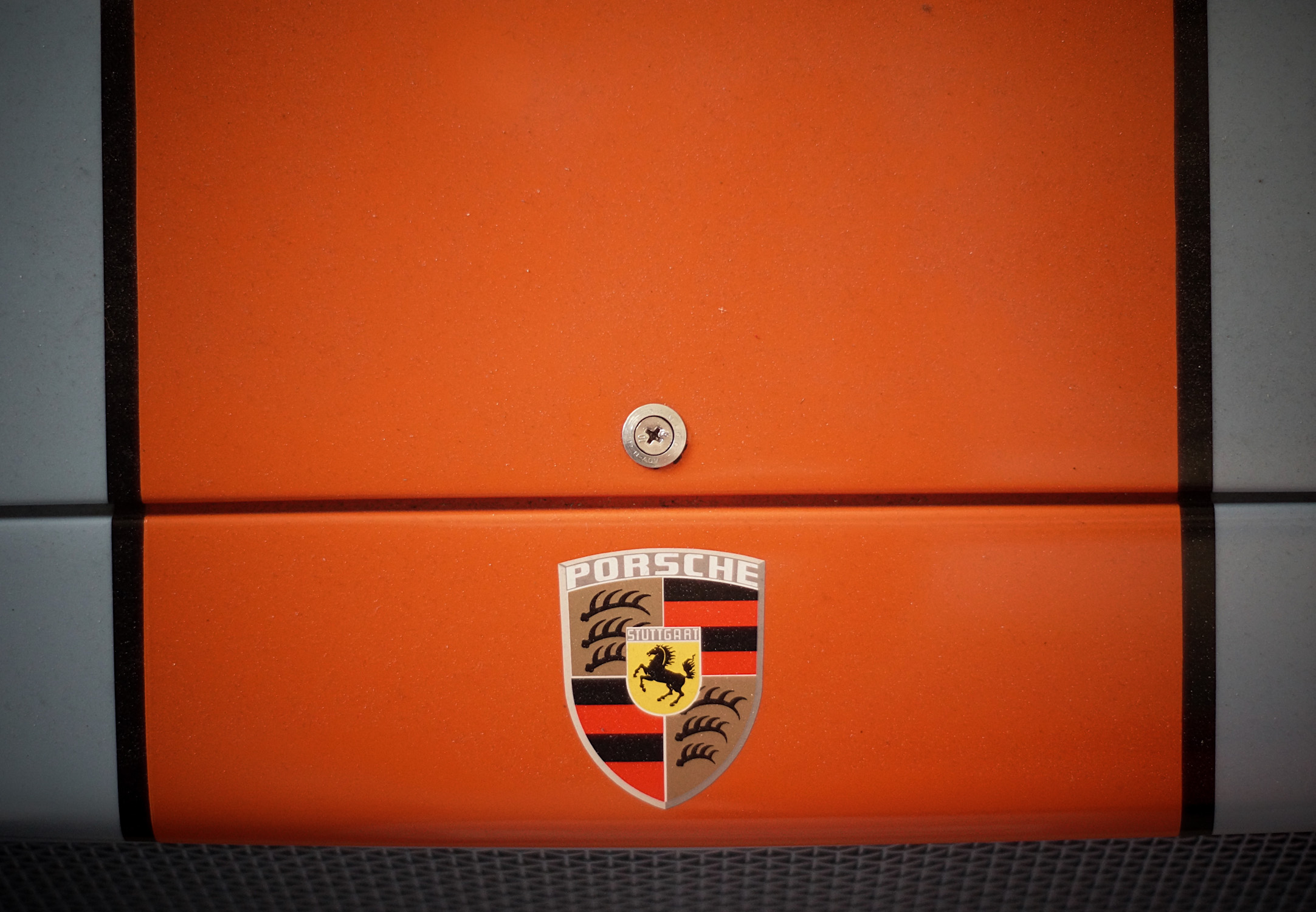
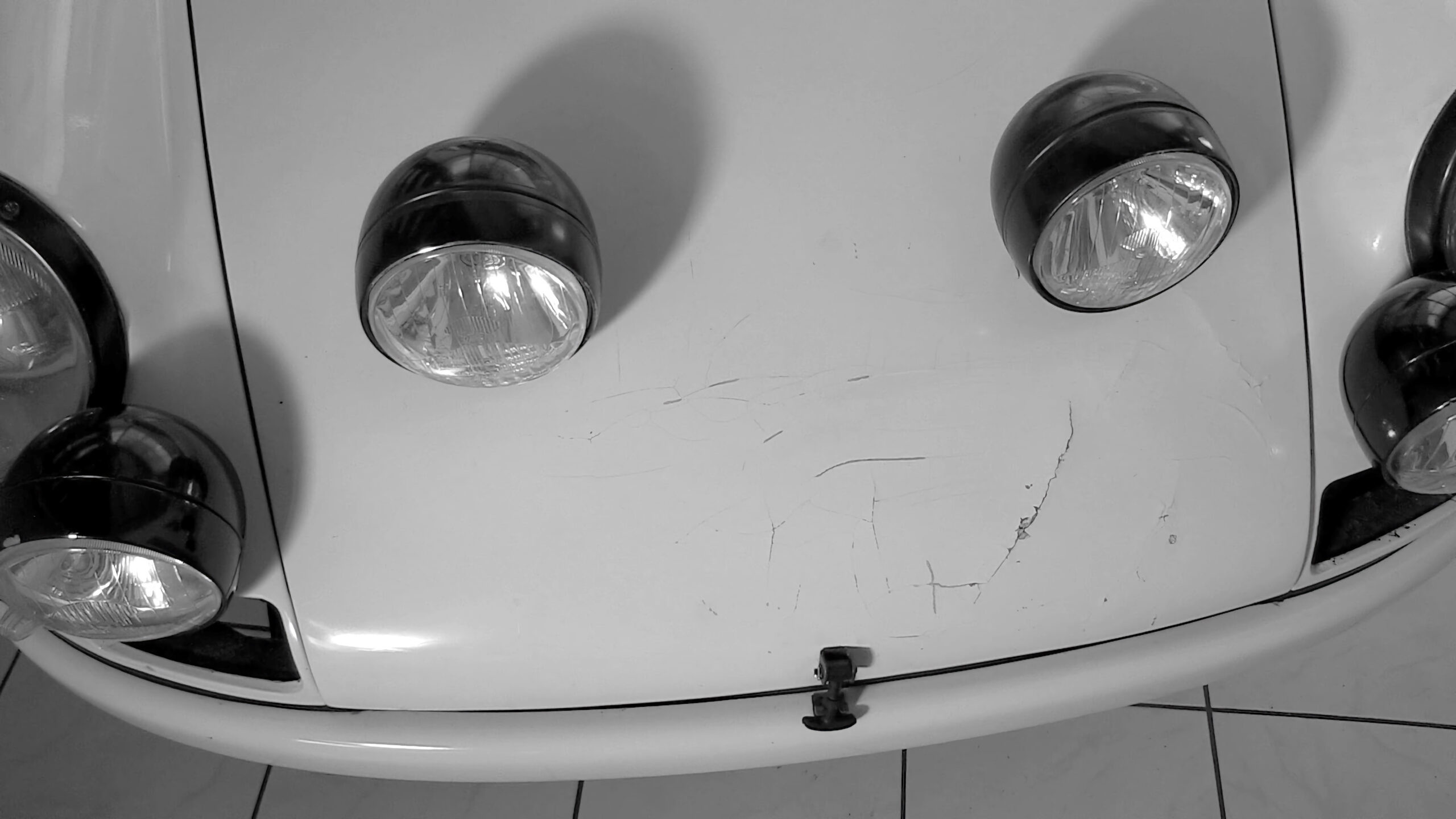
Porsche 911R owned by Jo Siffert
The Porsche 911 – the legend. Car enthusiasts from all over the world dream of it. But this example is even more than that. This 911 R belonged to racing legend Jo Siffert. At Orca Restoration, it underwent an elaborate restoration. The paintwork was restored to its original condition – but with the typical traces of ageing. The result is a beautiful vehicle.
Reading tip
A report on this vehicle and its restoration appeared as the cover story in the first issue 01/2023 of the Swiss magazine ‘Spirit’.
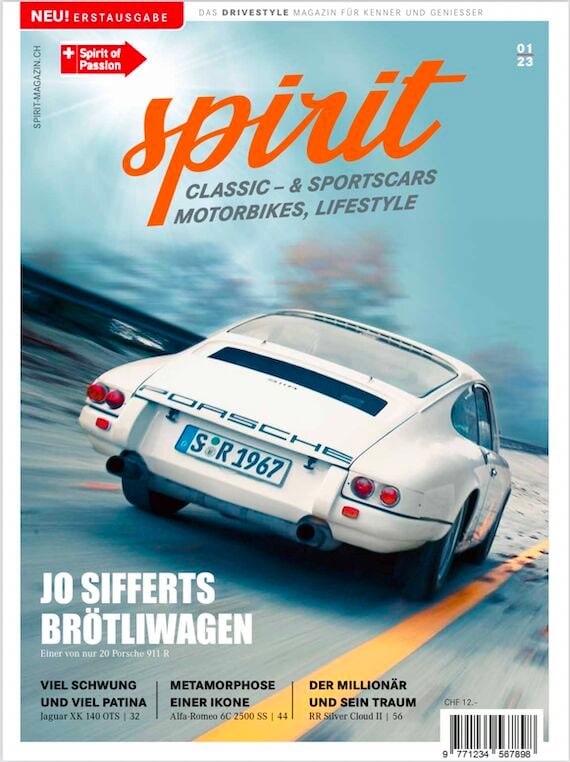
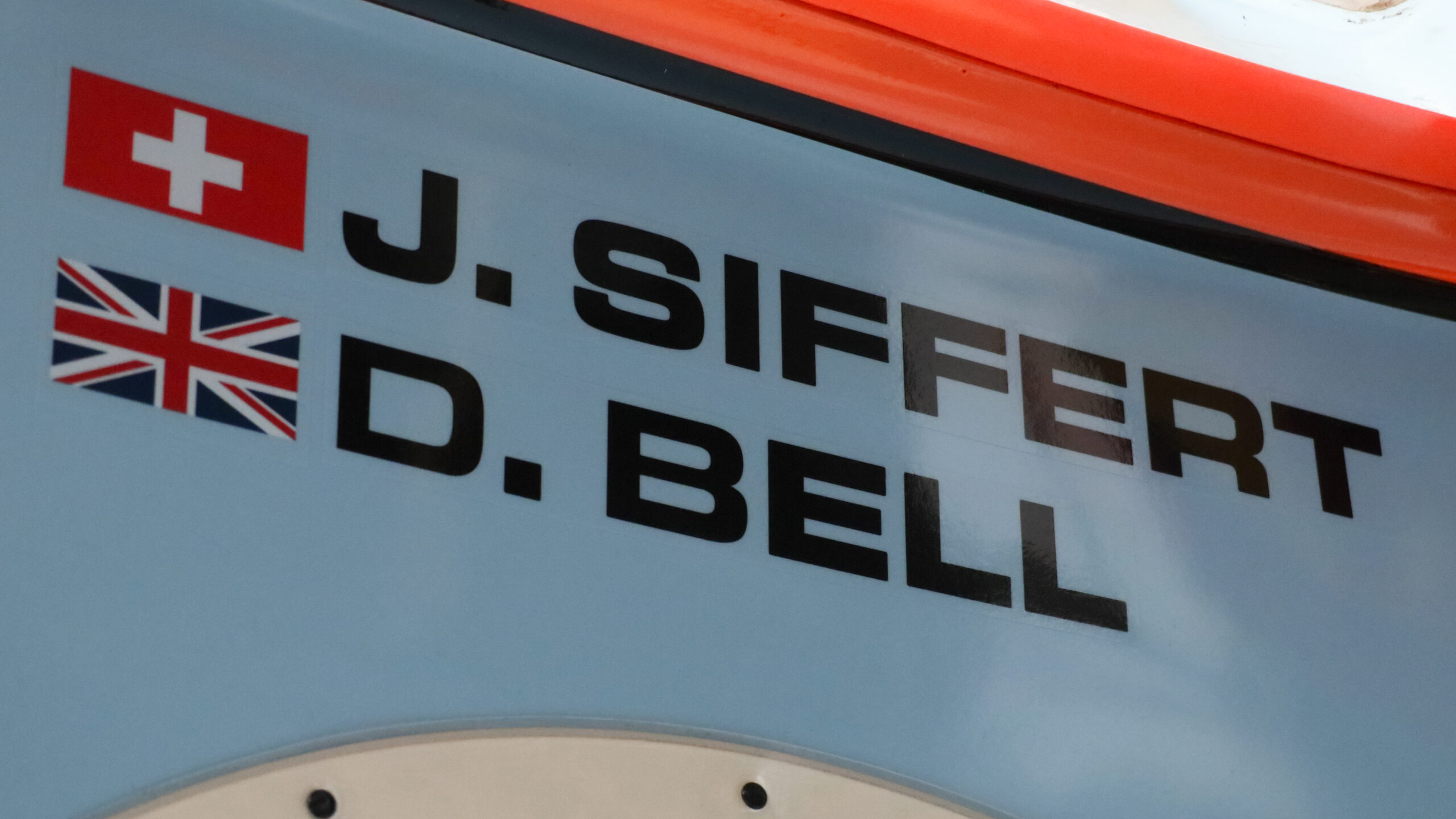
Porsche 917-045
This film shows the visual restoration of the Porsche 917 with chassis no. 045 at ORCA Restorations GmbH in Eberdingen over the period from 9 July – 1 September 2020. The 917/045 raced with Siffert/Bell at Le Mans in 1971 and was handed over by Porsche to the ACO Museum in Le Mans a year later as a permanent loan in Martini colours. For the special exhibition Porsche 917 ‘Made for Le Mans’ at the Le Mans Museum, the vehicle was restored to its original ‘71 livery – and all with the “paint damage” that occurs during the race.
With regard to the owner of the vehicle, the titles in the film are always in French.
.
We are delighted that the restoration of the Porsche 917 with chassis no. 045 is also shown on the official pages of the 24 Hours of Le Mans (from minute 6:08).



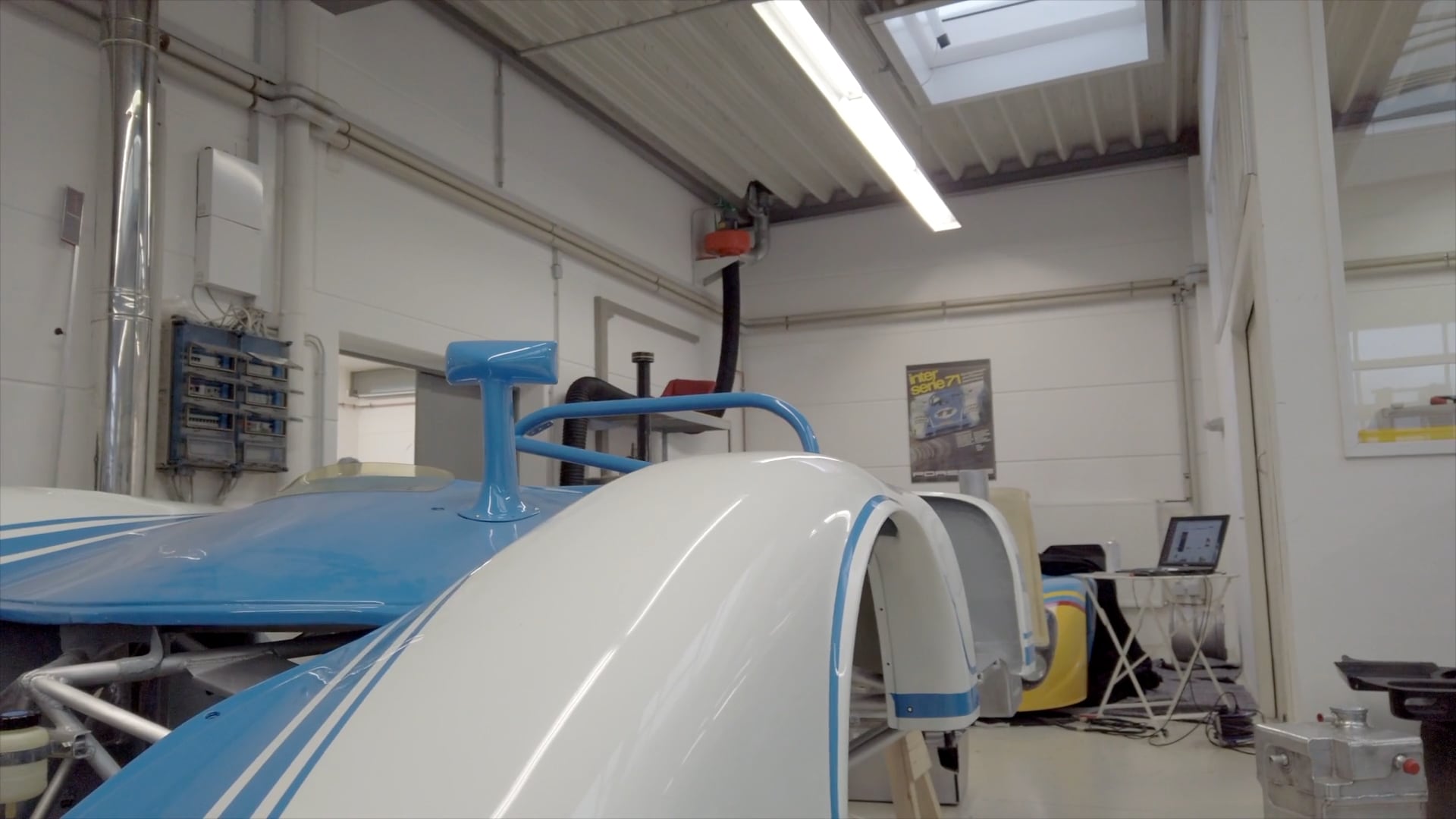
Porsche 917 Spyder
The original 1971 Interseries car – the third Porsche 917 to be rebuilt by Orca Restoration. Here are some details from the restoration and photos of the finished vehicle.
.

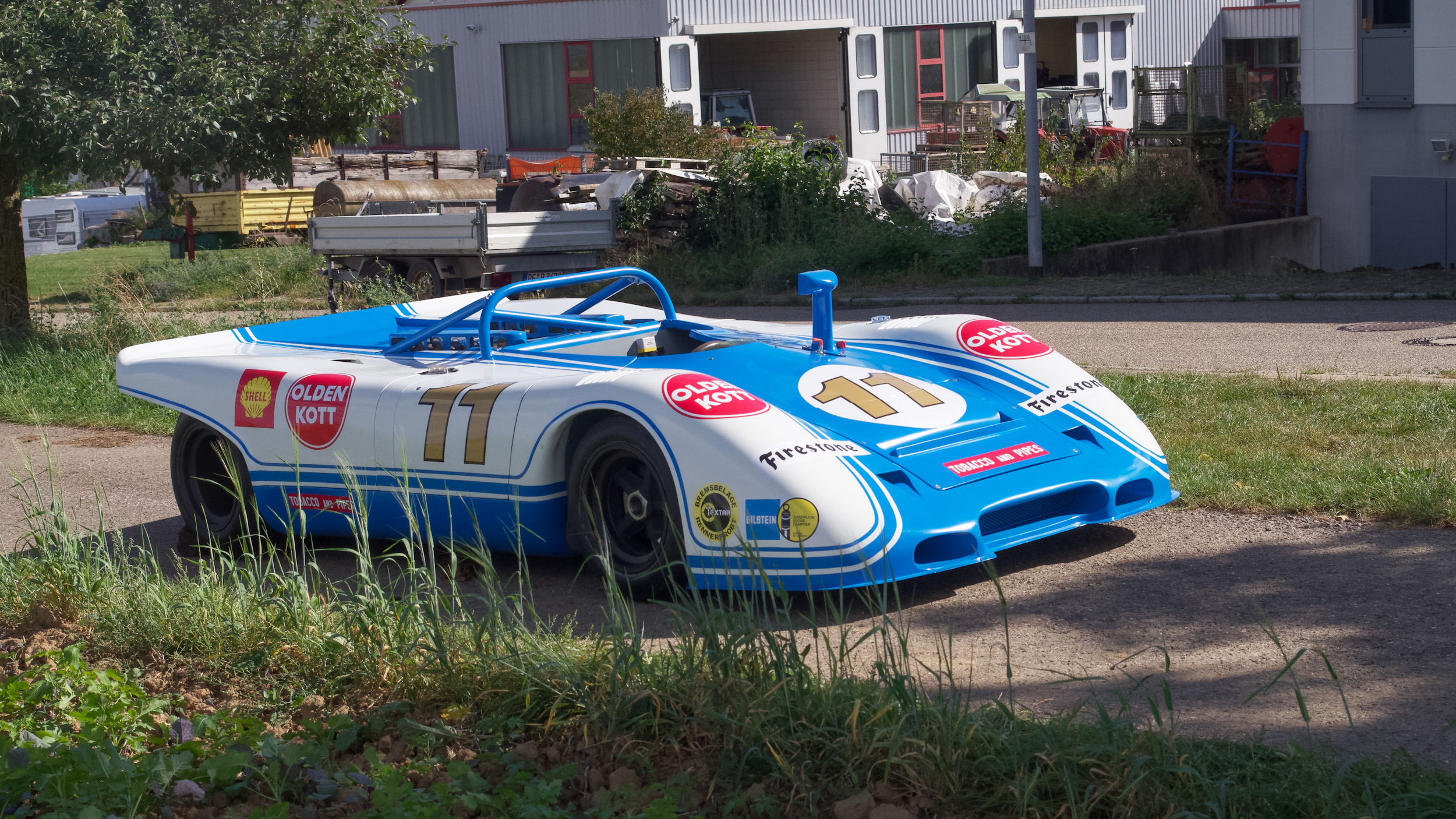
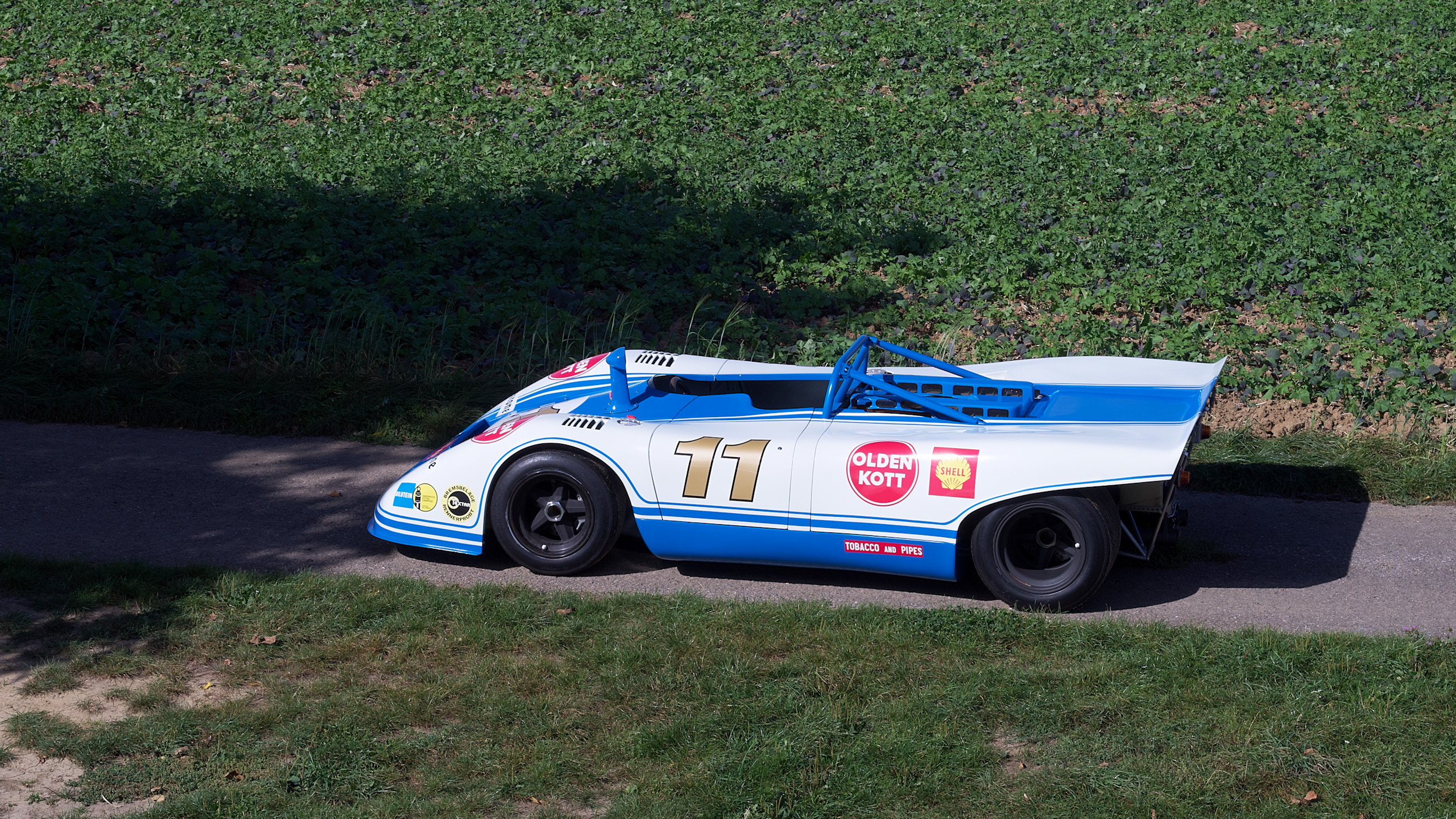
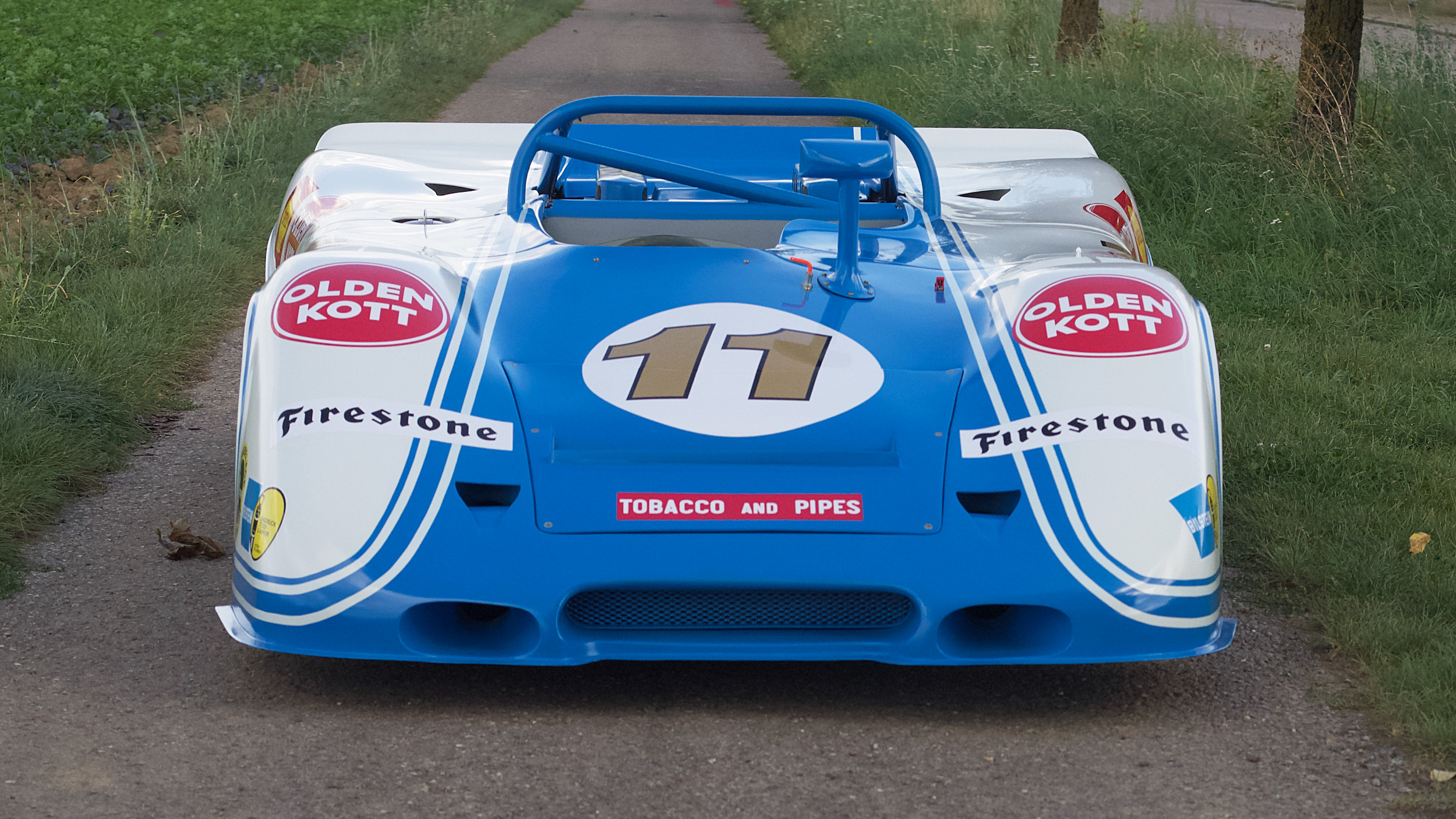
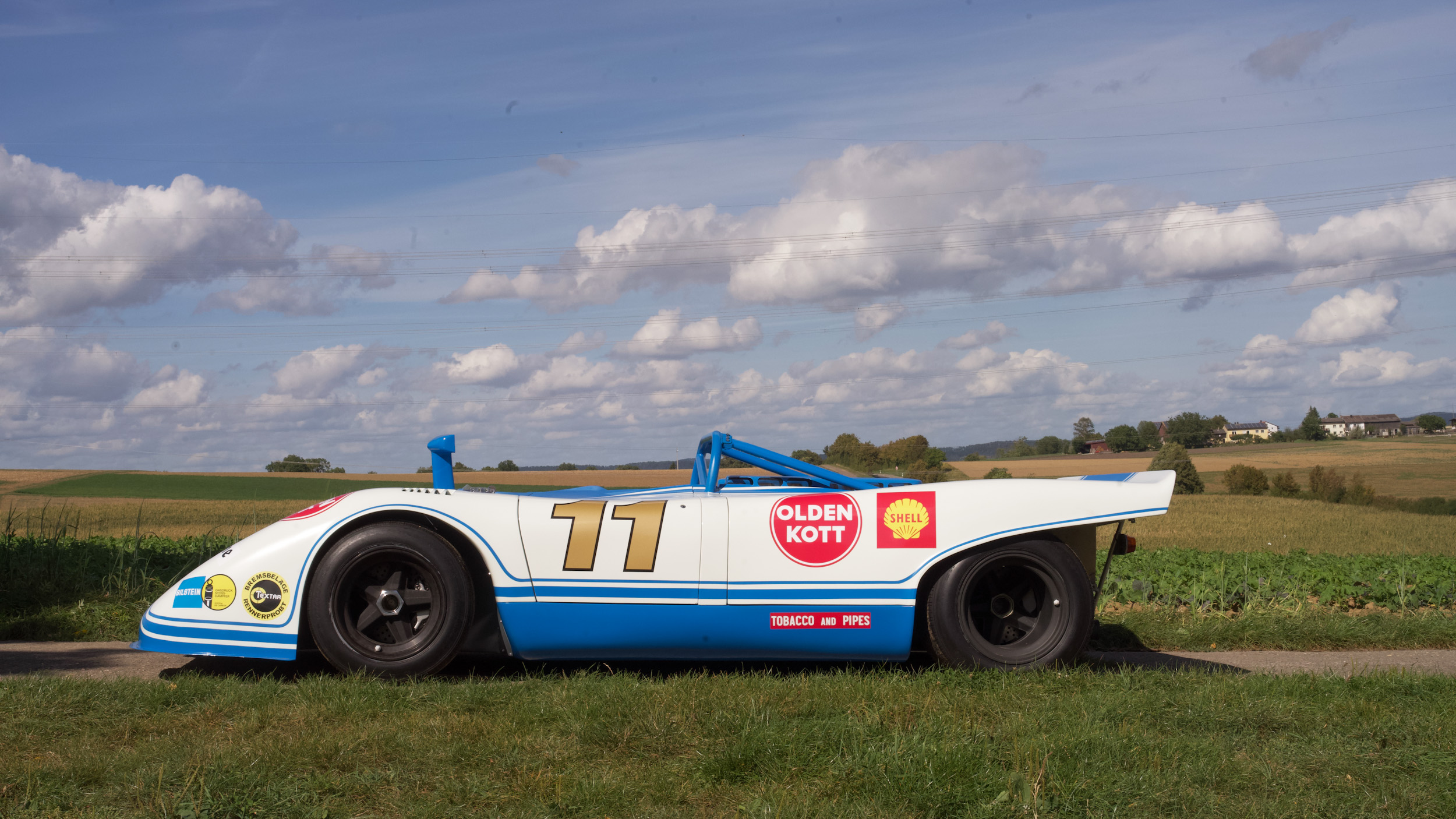

Porsche 910 Bergspyder
An exceptionally rare car – the Porsche Bergspyder 910. Alfred Kist from ORCA Restorations says: ‘This is one of two vehicles of this type still in existence. The other vehicle is in the Porsche Museum. In 1967, the car competed in the European Hill Climb Championship and won the hill climb at Mont Ventoux. We see extreme lightweight construction here, as the vehicle stands here, it weighs just 464 kg. In hill climbs, it was not so much the top speed that mattered, but the acceleration and, of course, the roadholding. The engine is again an eight-cylinder boxer engine, but also something special: it is a direct descendant of the former Porsche Formula 1 engine. This vehicle was completely rebuilt by Orca Restorations, as it had been extensively rebuilt and modified over the decades. The bodywork was completely rebuilt, the frame restored to its original condition and the entire technology overhauled. The car was literally stripped down to the last screw. But now it shines like it did when it was delivered in 1967.
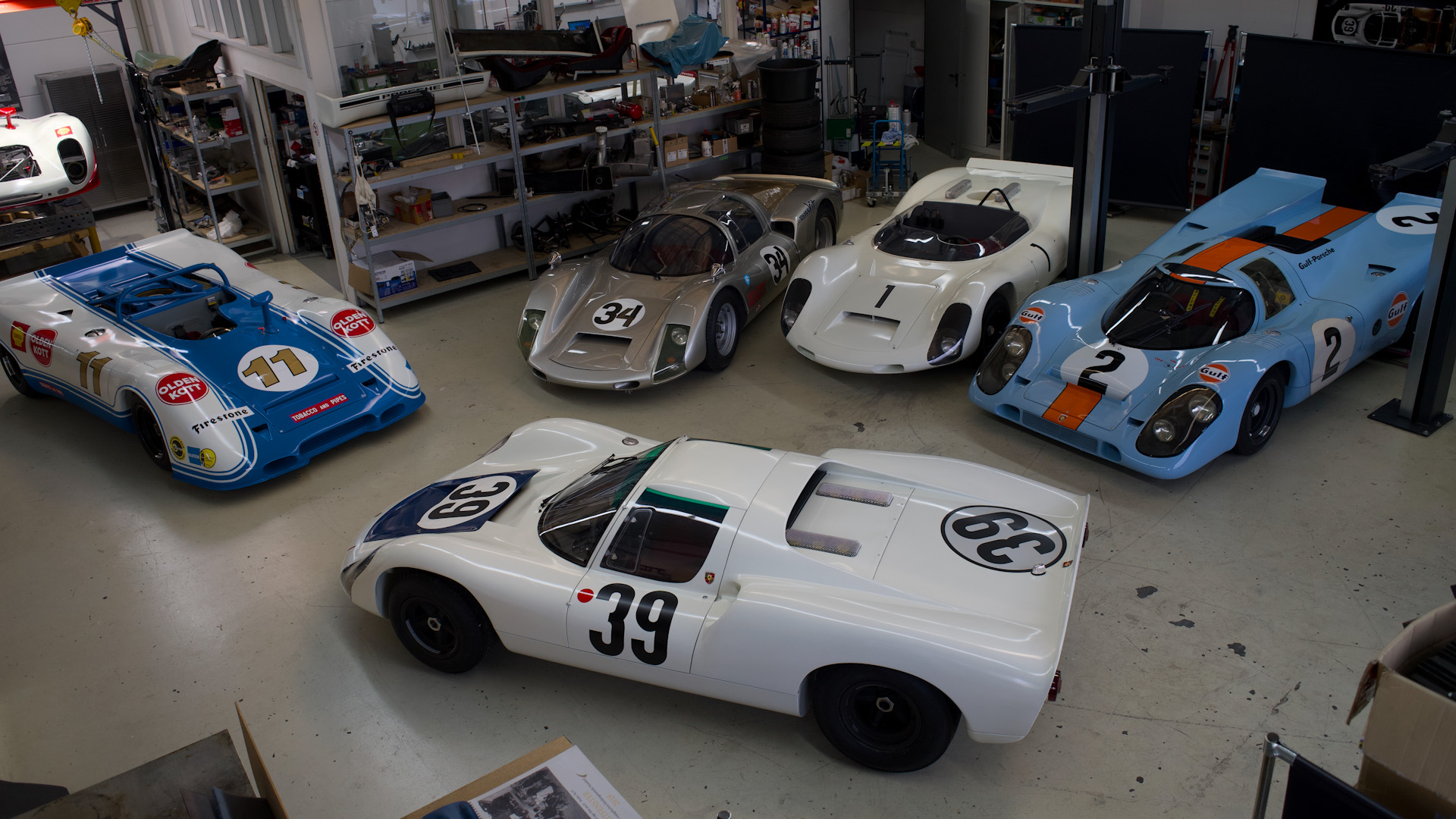
Five automotive gems...
10 January 2024 – two Porsche 917s, a Porsche 906, a Porsche 910 and a Porsche 910 Bergspyder. At ORCA Restoration GmbH, the vehicles are now sent to their owners after the work is done. We present the photos here quite simply – without music, without any fuss, just the pictures.
.
